On this day, I left the rented car at the hotel in Gundelfingen and took a local train to Freiburg.
On my way from the railway station to the downtown area, I walked past a park in which there is the Colombischlössle Archaeological Museum. I must admit that the materials I was using did not mention this museum at all and now I actually think that it would have been nice if I had visited the museum. Well, ok... the next time...
What caught my attention here, in the park beside which I was going, were plantings of different varieties of grapes.
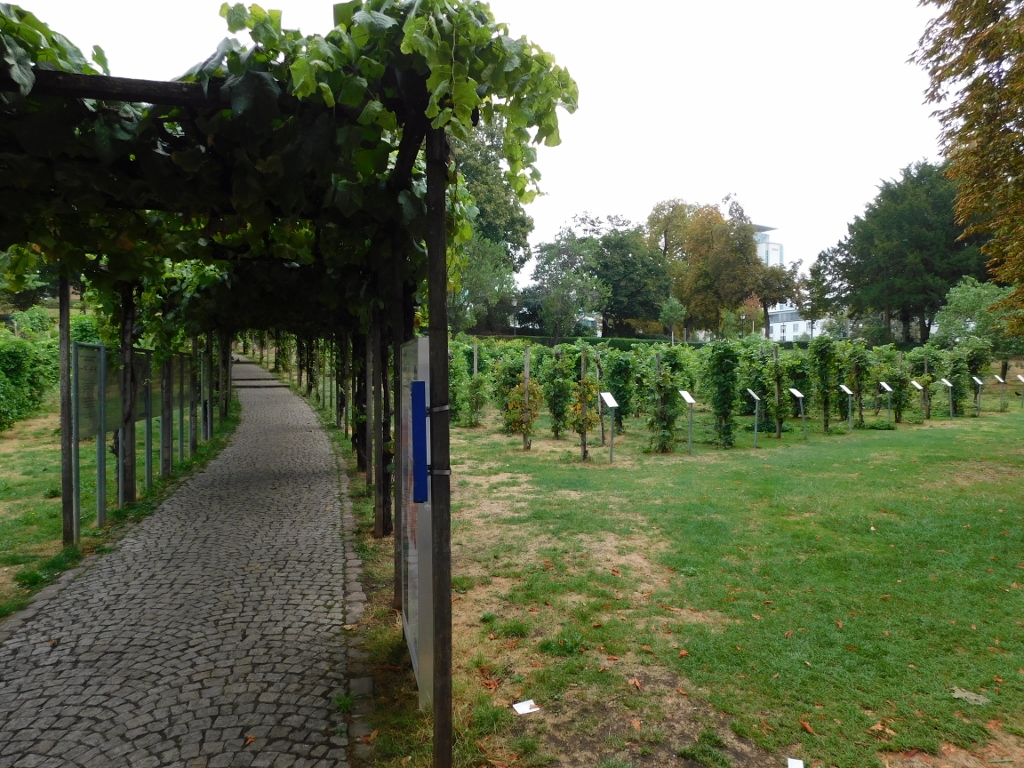 Park beside the archaeological museum with different plantings of grapevine
Park beside the archaeological museum with different plantings of grapevine
Freiburg is a city founded in 1120. Over time, it was ruled by different counts and from 1368 it voluntarily fell under the rule of the Habsburgs. In the 17th century it was also briefly a part of France. Nowadays, it is situated in the state of Baden-Württemberg and it has over 230.000 inhabitants. The full name of the city is Freiburg im Breisgau, which actually means Freiburg in Breisgau (name of the region).
One of the oldest and most prestigious universities in Germany founded in 1457 is located in Freiburg and the city also represents one of the best places from which one can visit the region of Schwarzwald (Black Forest), which I did partially the day before.
I was first in Freiburg, very briefly – only a few hours, many years ago when I travelled with Interrail pass around Europe and ever since it has remained in my memory as a very beautiful place. Now I wanted to visit it a little better and more thoroughly. And so I started along one of the streets that rather directly go from the railway station to the centre of the city. Its main advantage for me was that it was a pedestrian street.
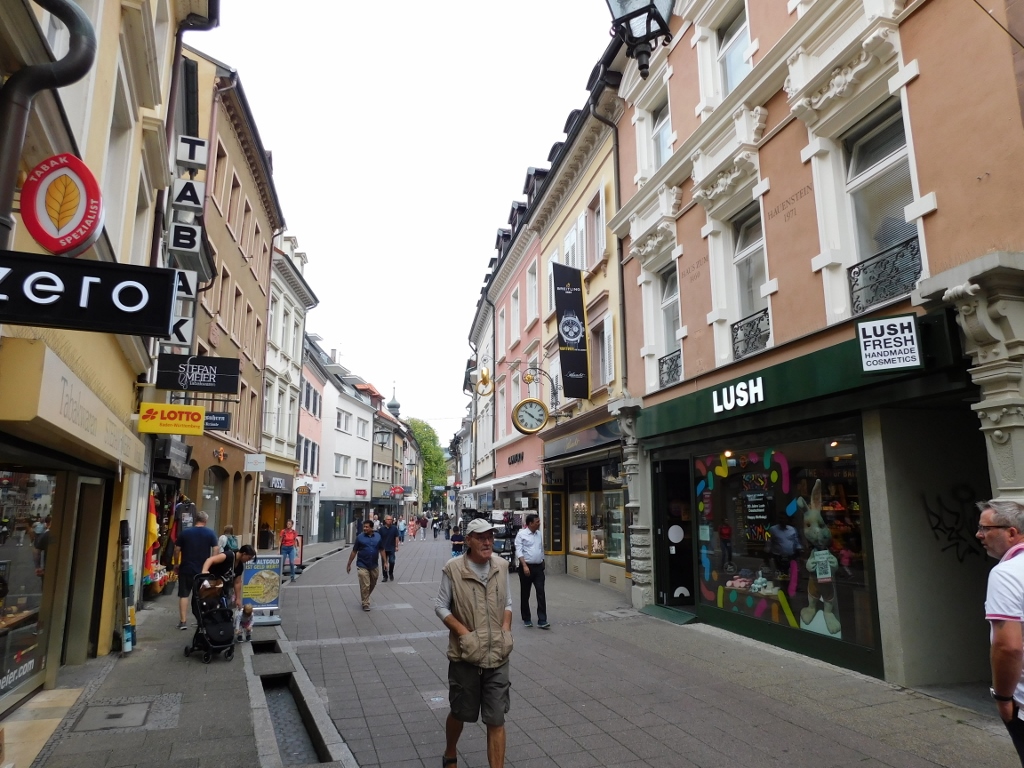 Pedestrian street in the centre of Freiburg
Pedestrian street in the centre of Freiburg
On the other hand, already here I got to know a detail that is linked precisely to Freiburg. These are the “Streams” (Bächle) or canals that can be seen throughout the old town and that were made already during the Middle Ages. Their purpose was multifold: on the one hand they drained any surplus of ground waters and on the other they provided water for extinguishing fires that were quite common back in the day.
Walking further towards the main square I also reached the Town Hall (Rathaus). It is interesting that nowadays the Town Hall uses over ten buildings while here in the Town Hall Square (Rathausplatz) one next to the other there are the most important ones – New Town Hall and Old Town Hall.
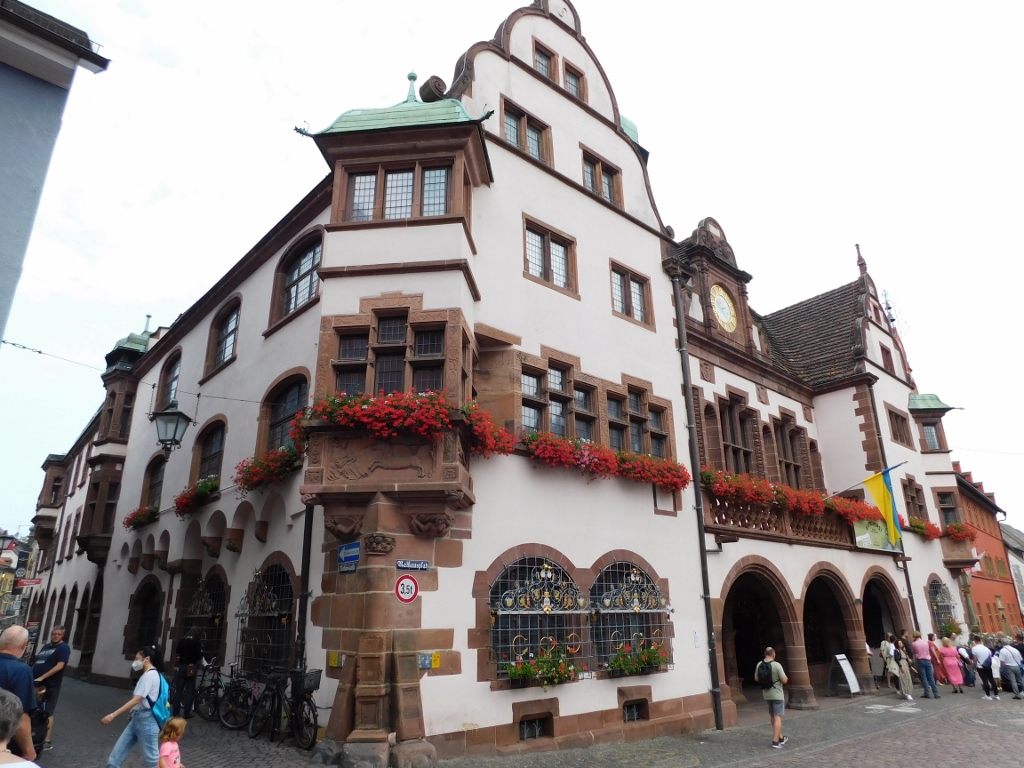 New Town Hall
New Town Hall
The building called the New Town Hall consists of two houses built in the first half of the 16th century and objectively speaking they are even older than the building called the Old Town Hall. The reason for this “new” is that this double structure used to belong to the University in Freiburg for over 300 years and then the city purchased it and turned it into a town hall in 1901.
Next to the New Town Hall there is also the Old Town Hall, while in-between there is a narrow street.
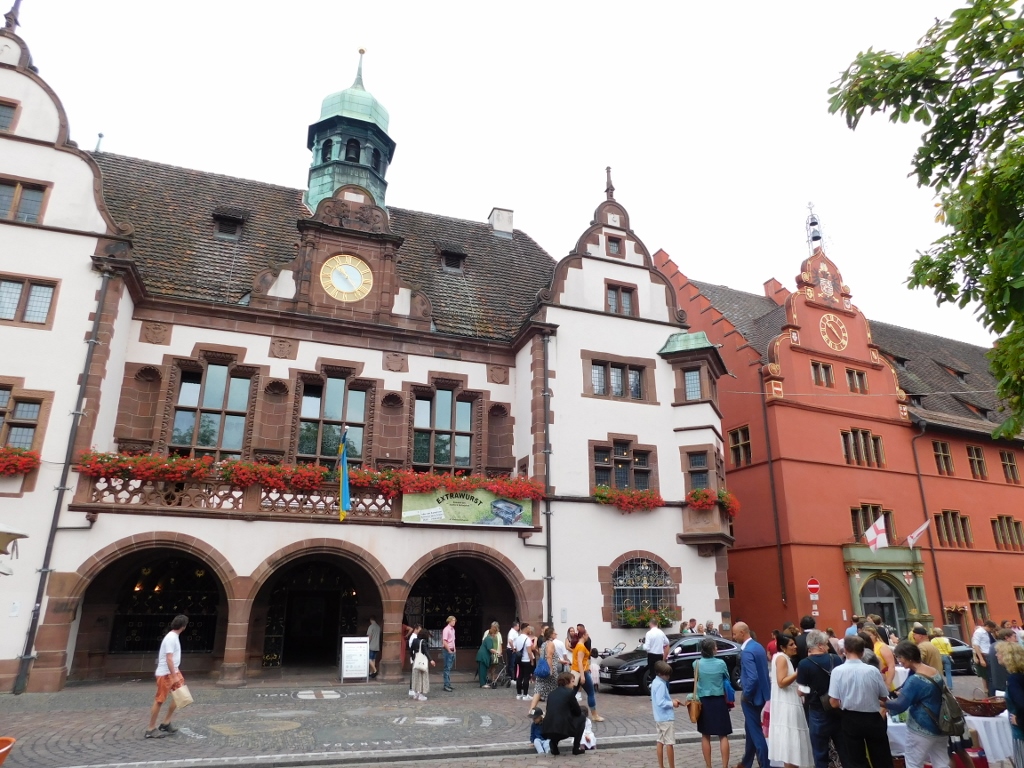 New Town Hall (white building) and Old Town Hall (red building)
New Town Hall (white building) and Old Town Hall (red building)
The Old Town Hall was built between 1557 and 1559. What can be seen here today, however, is a complete reconstruction since the original building burned down to the ground in the allied bombing of Freiburg in November 1944.
After a short stay here, I continued in the direction of the main square around the cathedral, but only up to the large street called Kaiser-Joseph-Straße. There I first took a photo of Martinstor and Bertoldsbrunnen, but I dealt with them a little later.
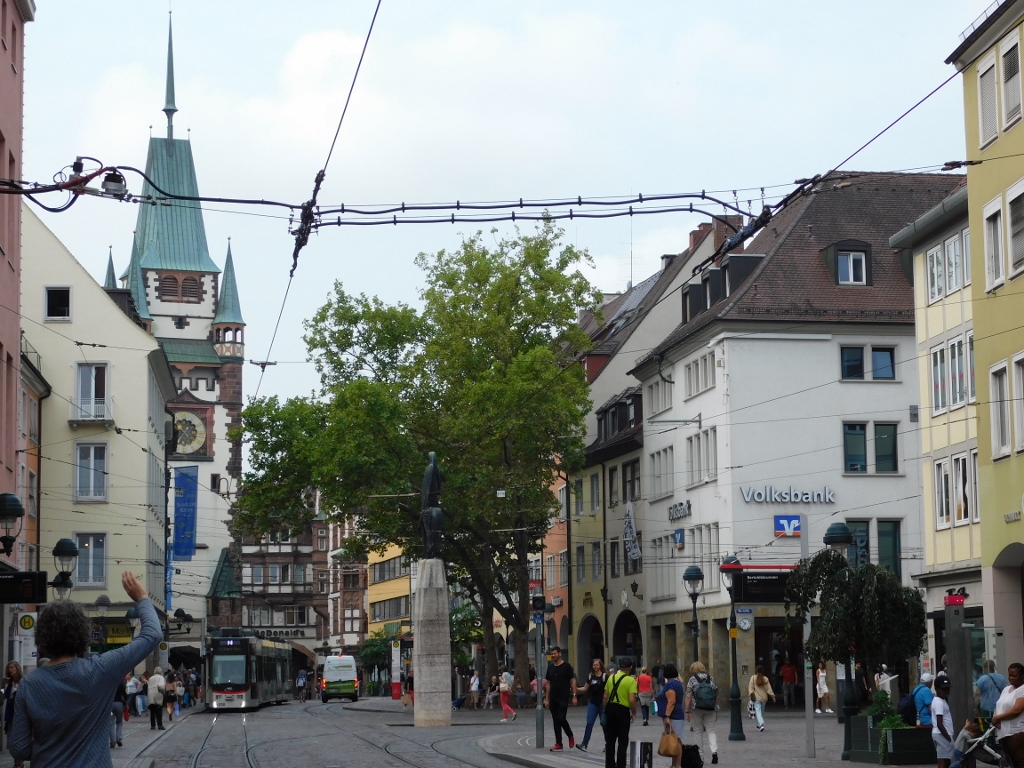 Kaiser-Joseph-Straße
Kaiser-Joseph-Straße
For now, I went to an interesting house. This is the Whale House (Haus zum Walfisch) built between 1514 and 1516.
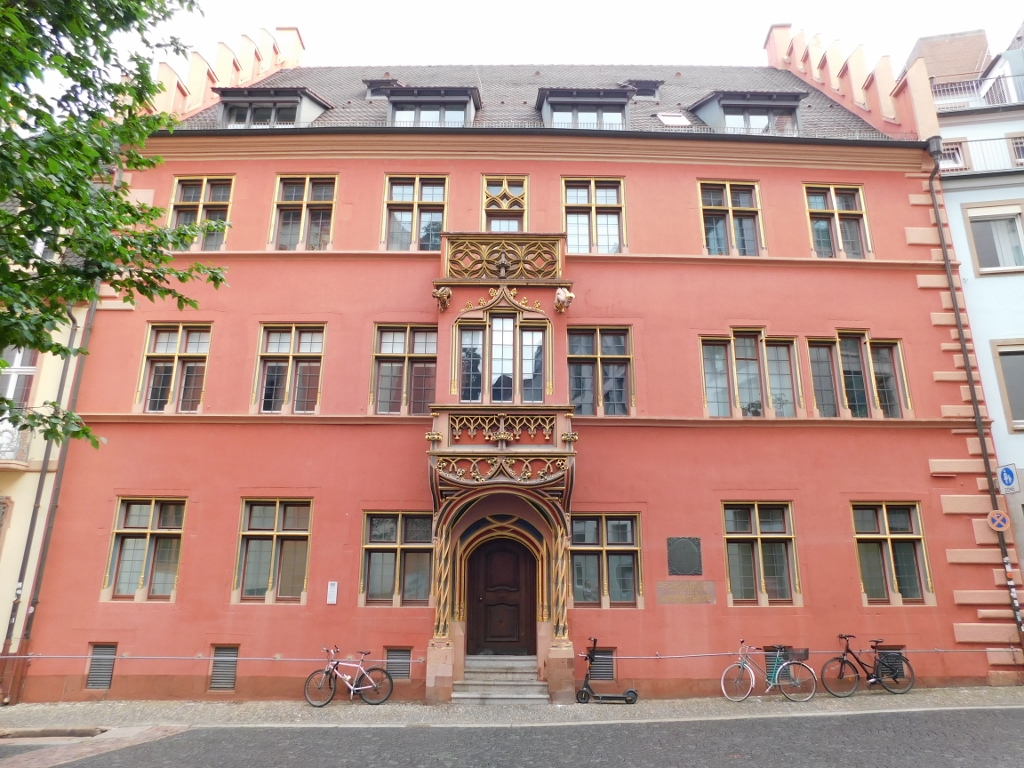 Whale House
Whale House
The house is renowned for its facade, primarily for its bay window, while its interesting name that is first mentioned in a document from 1565 is believed to be linked to the Bible story about Jonah and the whale.
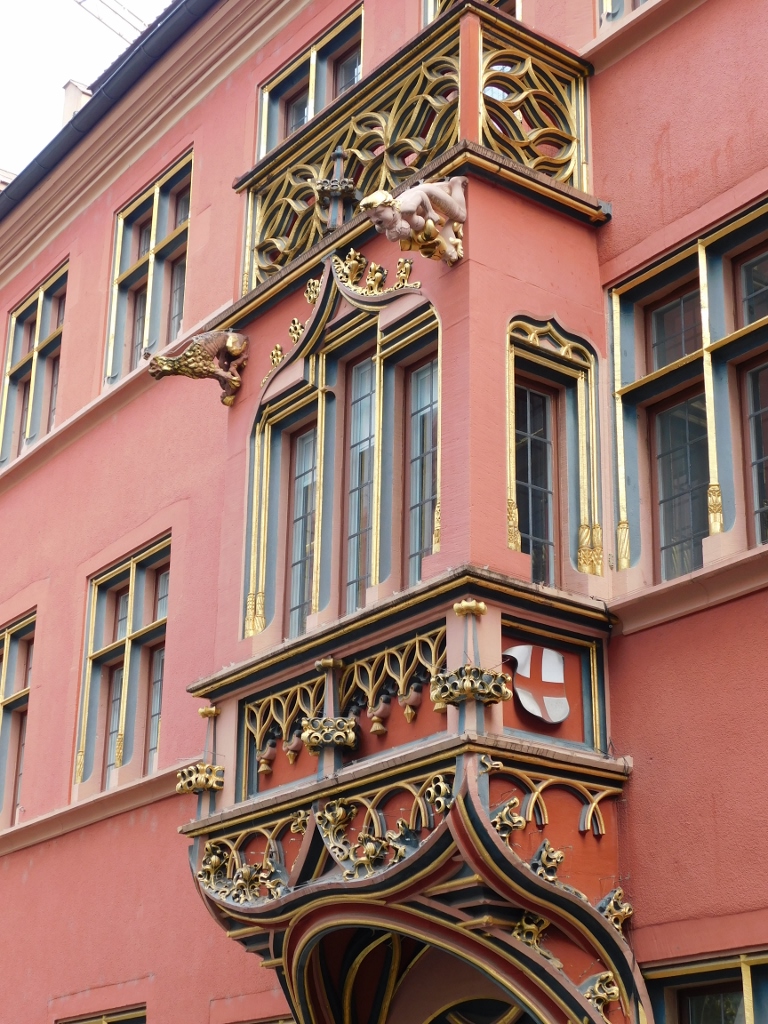 Whale House, a detail
Whale House, a detail
It is also interesting that Erasmus of Rotterdam lived in this house from 1529 to 1531.
And now finally came the time for me to go to the square around Freiburg’s cathedral that is aptly named the Minster Square (Münsterplatz), which means cathedral square. There are houses from different periods around this picturesque square and consequently these houses were built in different styles, from Gothic to Rococo, but what I first faced here was a green market. I was here on a Saturday, so I first thought that it was a market day, but as I found out later the green market operates here every day except on Sunday.
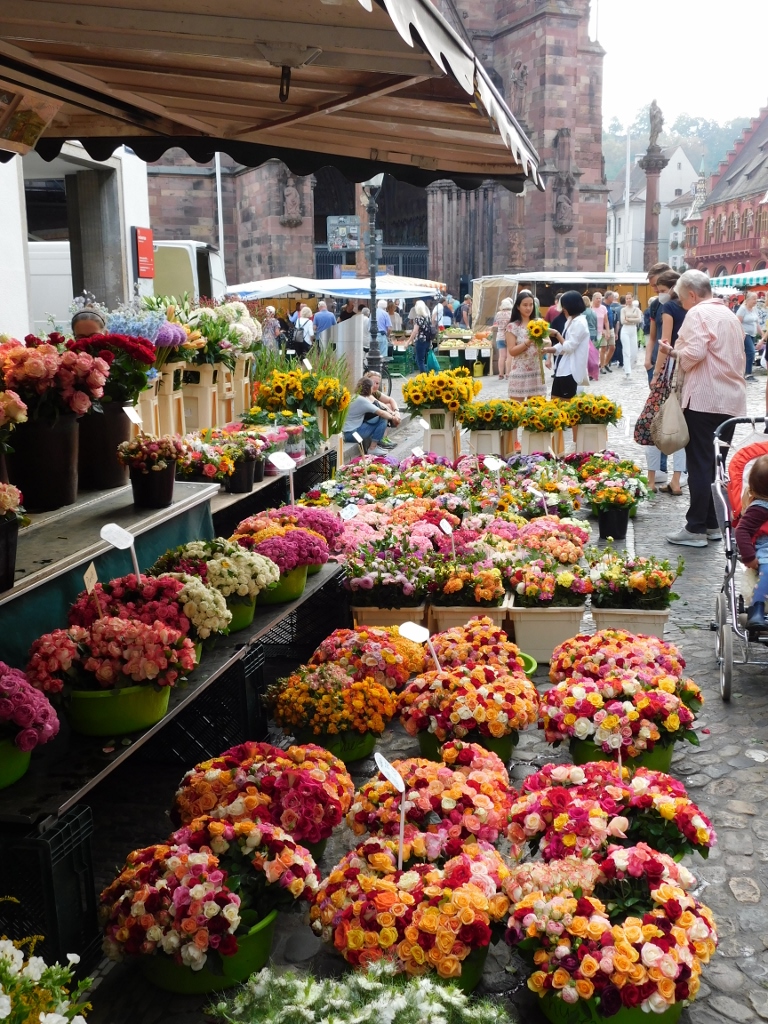 Market at the Minster Square (the cathedral can be discerned in the background)
Market at the Minster Square (the cathedral can be discerned in the background)
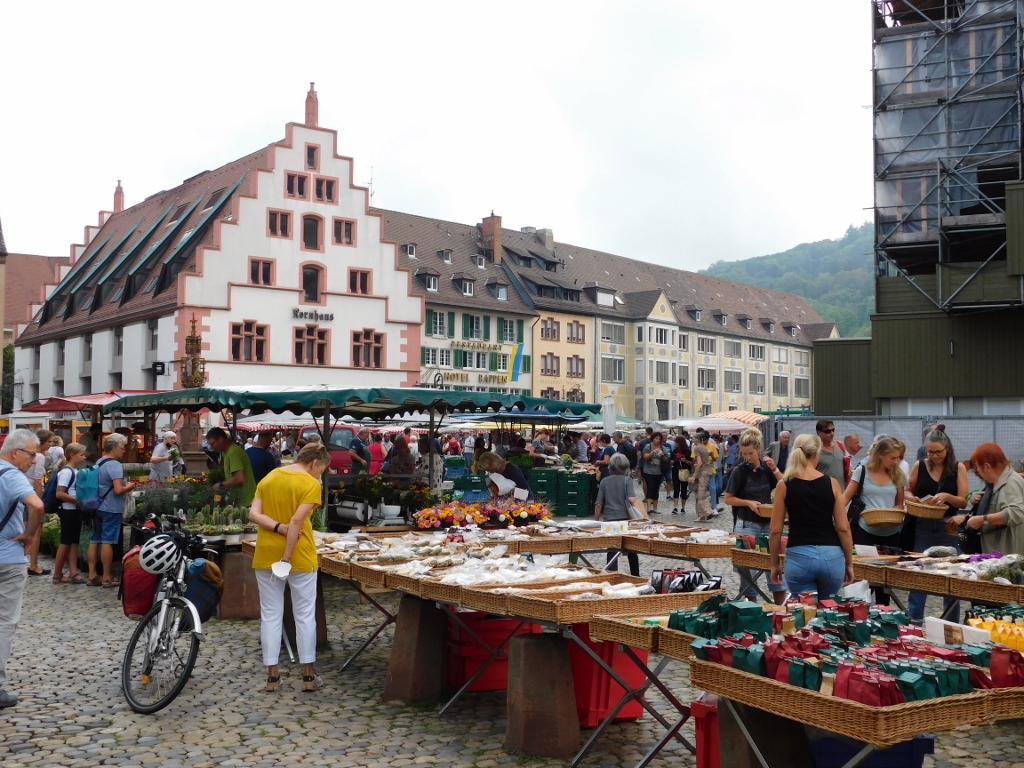 Market at the Minster Square
Market at the Minster Square
I walked a little around the stalls and then I dedicated my attention to the Cathedral that is, as I’ve said, called Freiburg Minster (Freiburg Münster).
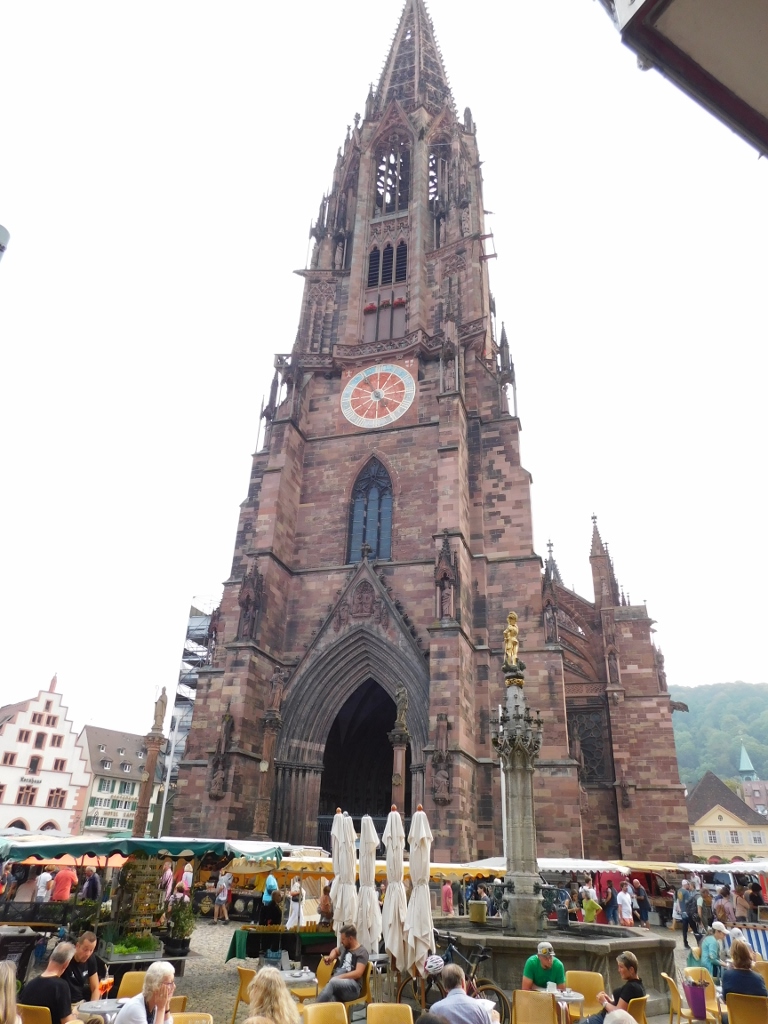 Freiburg Cathedral
Freiburg Cathedral
The construction of the cathedral started around 1200 and at the time it was conceived as a basilica built in the Romanesque style, but by the time it was finished in 1513 it had already obtained all the characteristics of the French Gothic style.
The most important part of the cathedral is certainly its impressive West Tower, i.e., the tower that rises above its west facade where the entrance is. The tower is 116 m high and it is possible to climb to its top. It is interesting that the tickets are paid for somewhere up. When I say “somewhere up” this is because I did not go there, since there is no lift, but there are 333 steps. I guess when the visitor covers these many steps, they exhibit a clear determination not to give up and it is only up there that the tickets are sold. For my part, I had no intention of climbing this much, but rather headed for the interior of the cathedral in order to visit it in this way.
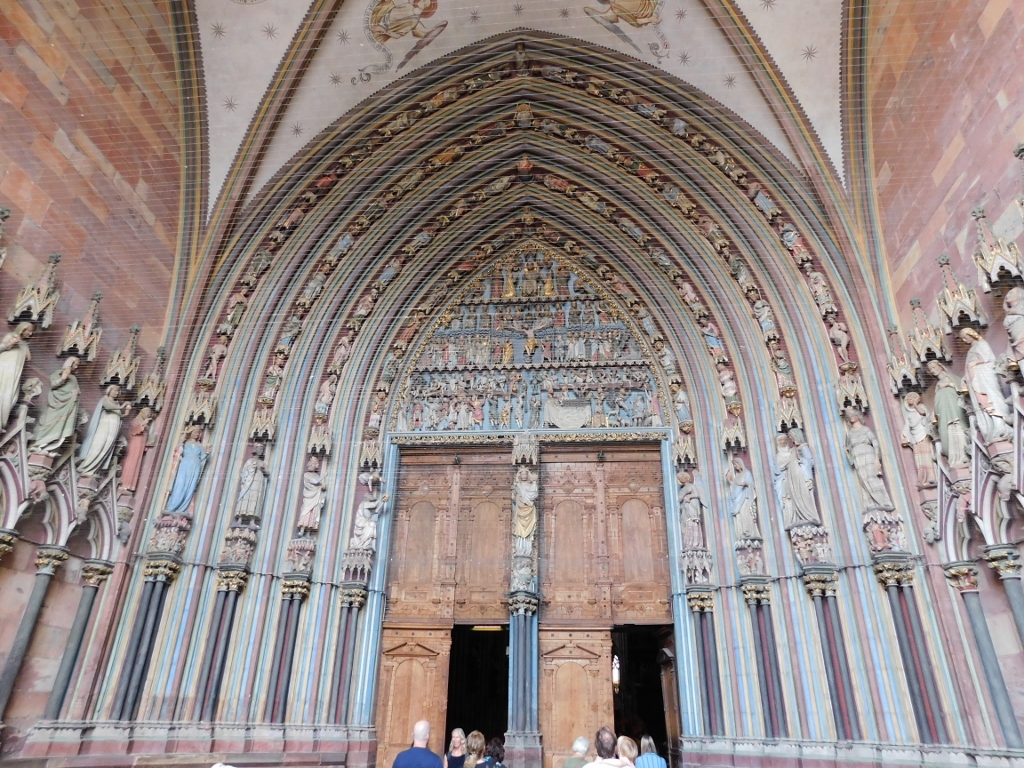 Freiburg cathedral, the entrance
Freiburg cathedral, the entrance
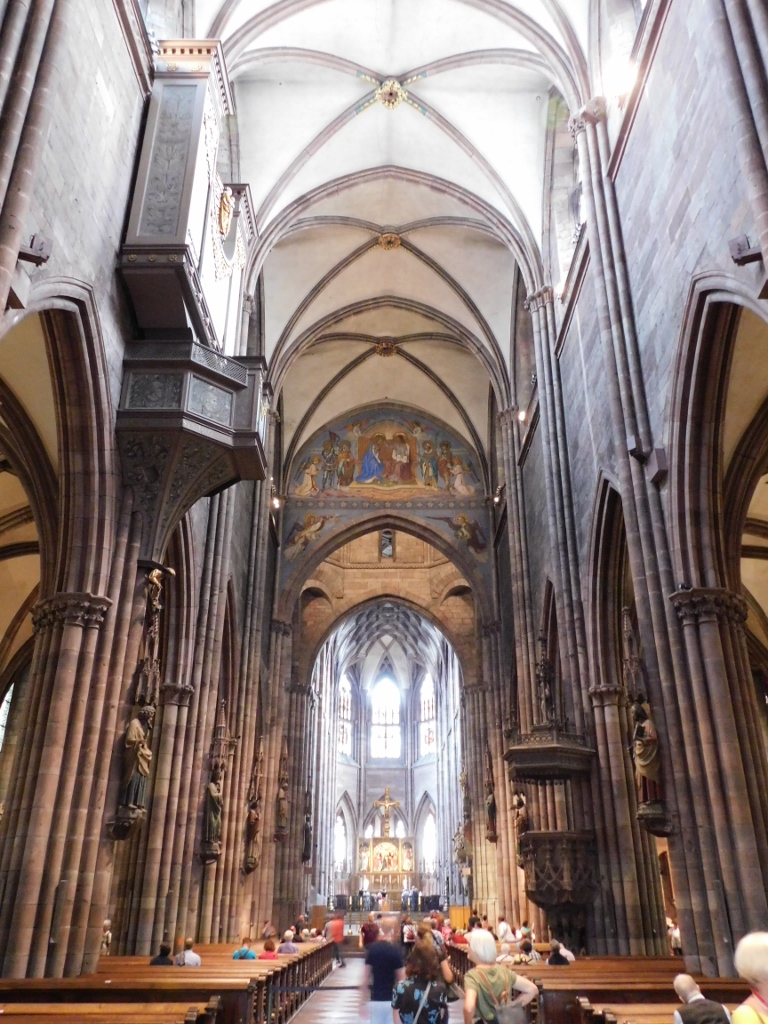 Freiburg Cathedral, the interior
Freiburg Cathedral, the interior
In the back of the central nave, there is the Main Altar that is also one of the more important parts of the cathedral and that is characterised by the painting of the coronation of the Virgin in the central section from 1512-16.
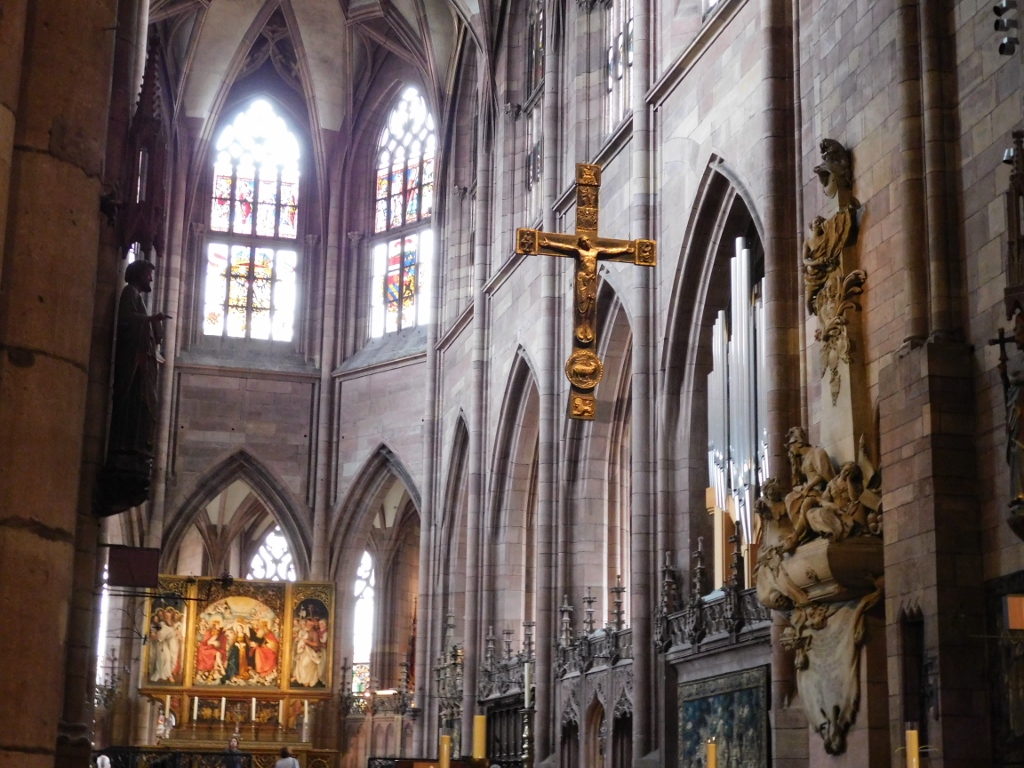 Freiburg Cathedral
Freiburg Cathedral
Above the entrance, there is a gallery with the organ, while the large window openings are decorated with impressive stained glass.
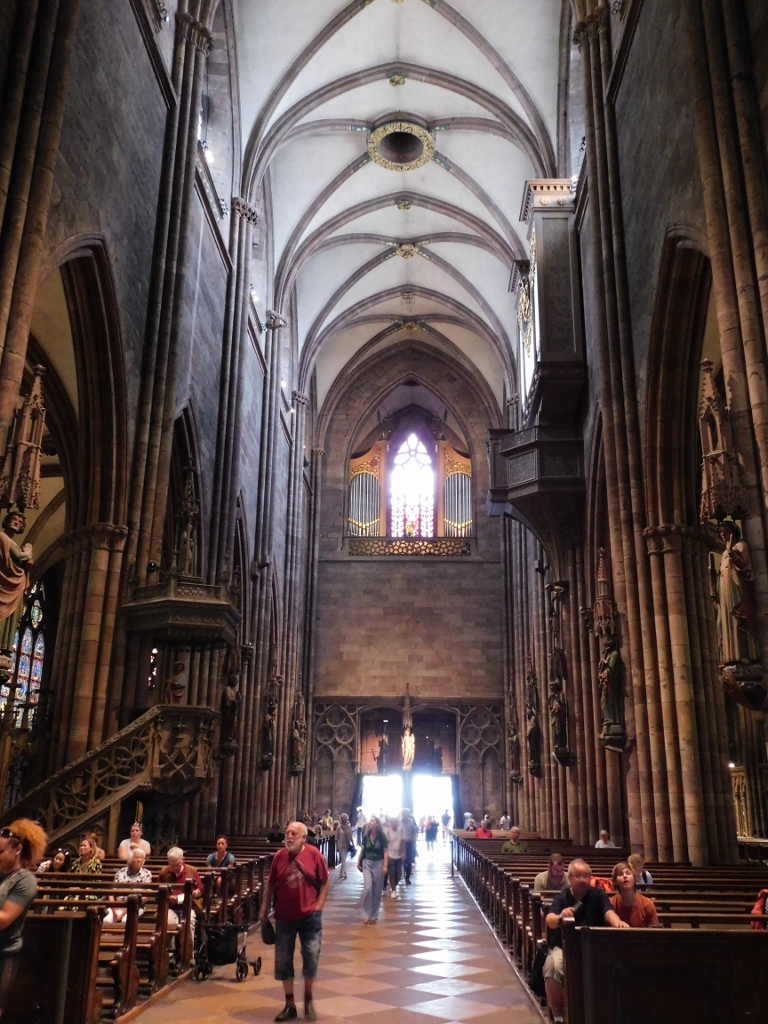 Freiburg Cathedral
Freiburg Cathedral
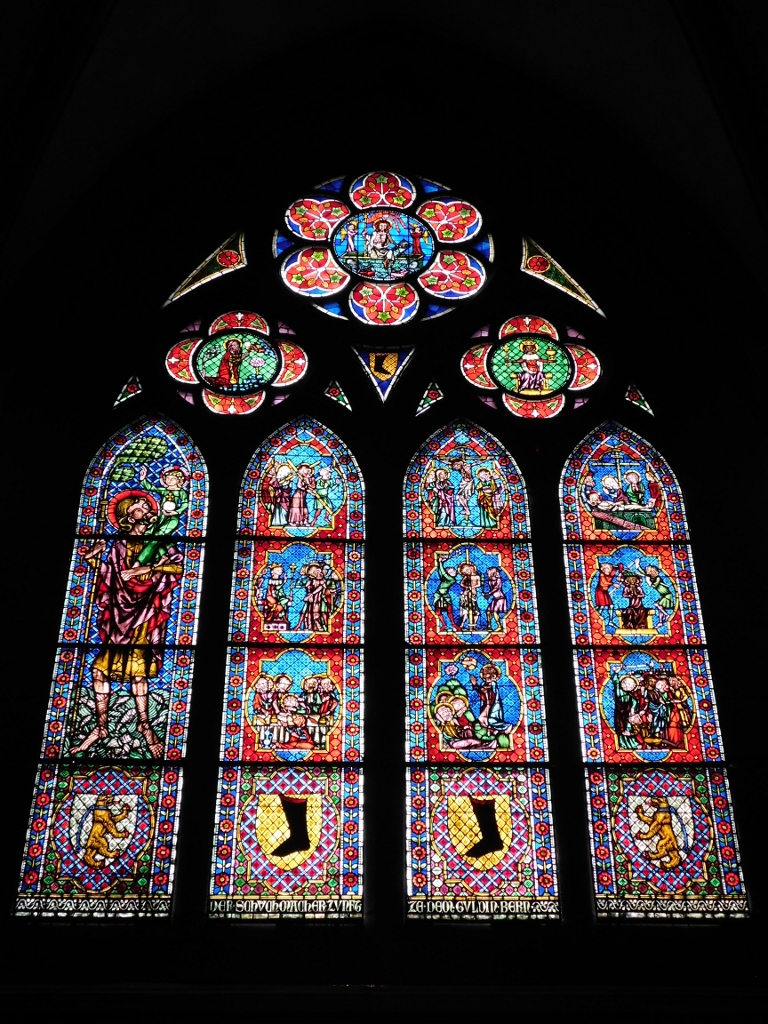 Freiburg Cathedral, a detail
Freiburg Cathedral, a detail
When I got out to the square again, first I took note of [St.] George Fountain (Georgsbrunnen) that is located close to the southwest corner of the cathedral.
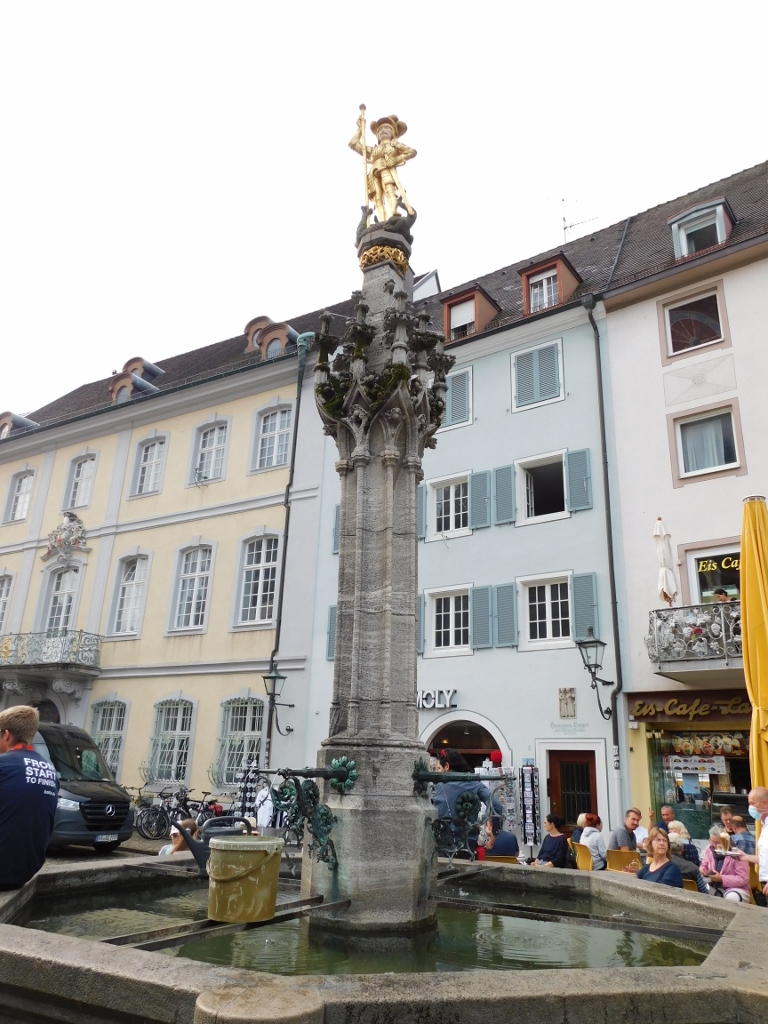 George Fountain
George Fountain
The first fountain in this place was built in the 14th century, but it was restored several times and what can be seen here today is a 1935 reconstruction of the version of the fountain from the beginning of the 16th century. It is dedicated to St. George who is the patron saint of the city. As it may be seen in the photo, at the time of my visit somebody had placed a bucket in order to fill it with the water from the fountain. Namely, the surroundings of Freiburg are rich in water and in several places there are running fountains where water can be drunk without any problems to this very day.
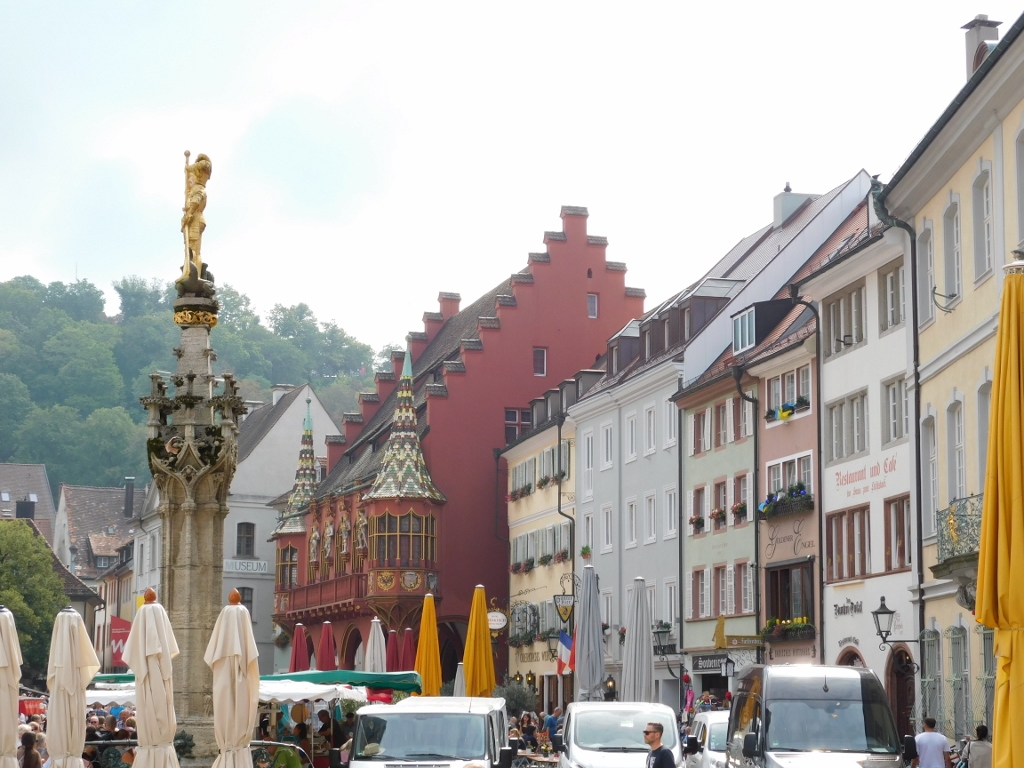 George Fountain with the red Historical Department Store a little farther away
George Fountain with the red Historical Department Store a little farther away
Now I went to see the red building that could be discerned in the photo above. The literal translation of its name is the Historical Department Store (Historisches Kaufhaus), although this is more of a “merchants’ hall.” Namely, this 14th century house used to be used for the municipal market goods administration and customs clearance in Freiburg and not as a department store in today’s meaning of the term. It was also used by local merchants as the venue for their meetings, various gatherings, etc.
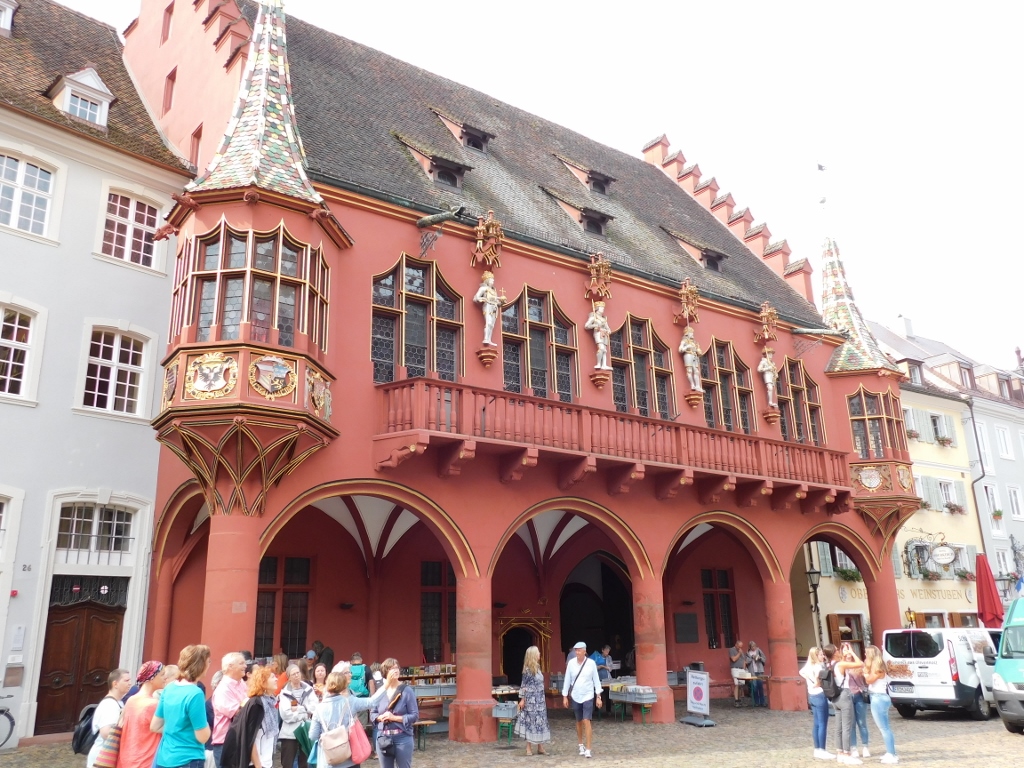 Historical Merchants’ Hall
Historical Merchants’ Hall
From 1520-1532 when it was first built, the building had additions or modifications done on it several times, while its present-day form was given to it in 1988 during a detailed renovation. It contains numerous beautiful and interesting details, and here is a photo of some of them.
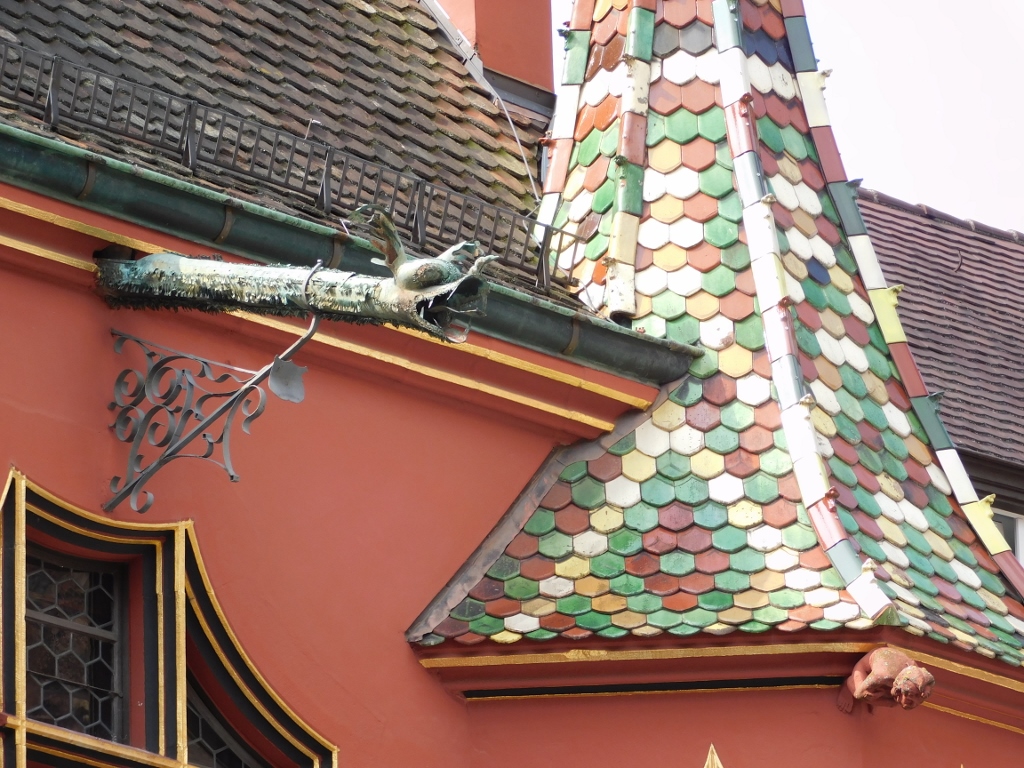 Historical Merchants’ Hall, details
Historical Merchants’ Hall, details
This beautiful building was constructed in such a way that it faces the cathedral and this can be seen nicely in the following photo.
 Historical Merchants’ Hall is to the left and the cathedral is to the right
Historical Merchants’ Hall is to the left and the cathedral is to the right
While I moved around taking photos, the sky started to clear up and thus the sunlight began to shine on the cathedral.
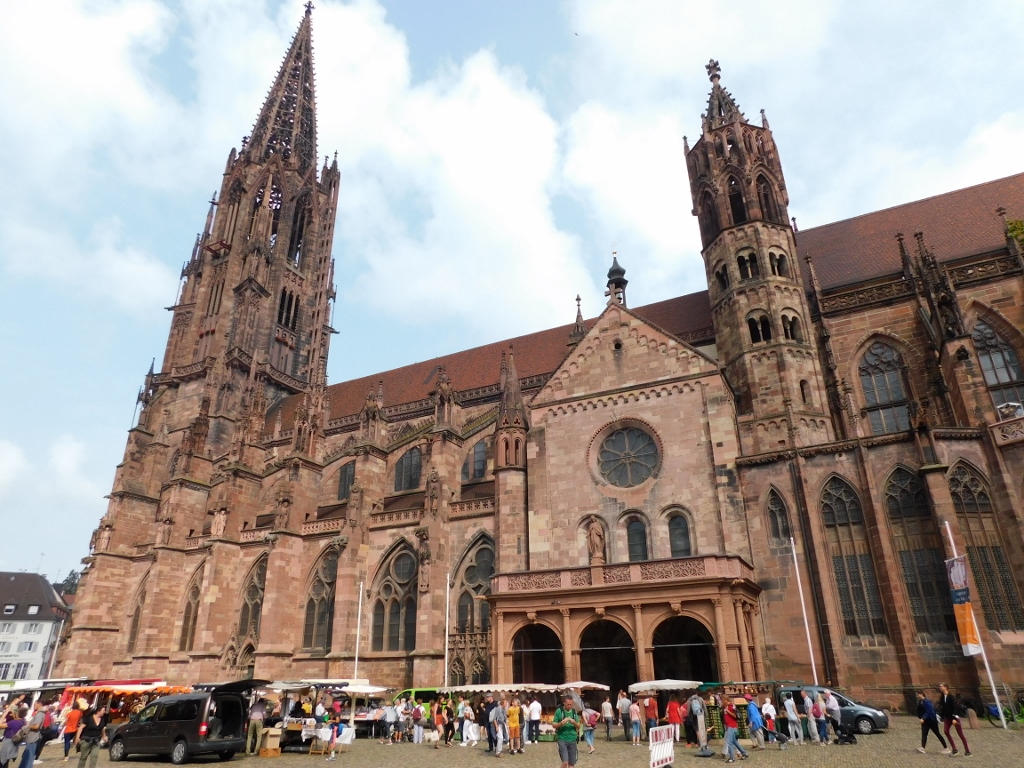 Freiburg Cathedral
Freiburg Cathedral
And now I started with a somewhat broader walk around the old part of Freiburg. First I went to a renowned landmark of the city, Bertold’s Fountain (Bertholdsbrunnen), that is located in the middle of a large cross-road where trams also operate.
On the basis of the description I had, I imagined a traditional fountain, so I was a little confused when I saw the monument placed here.
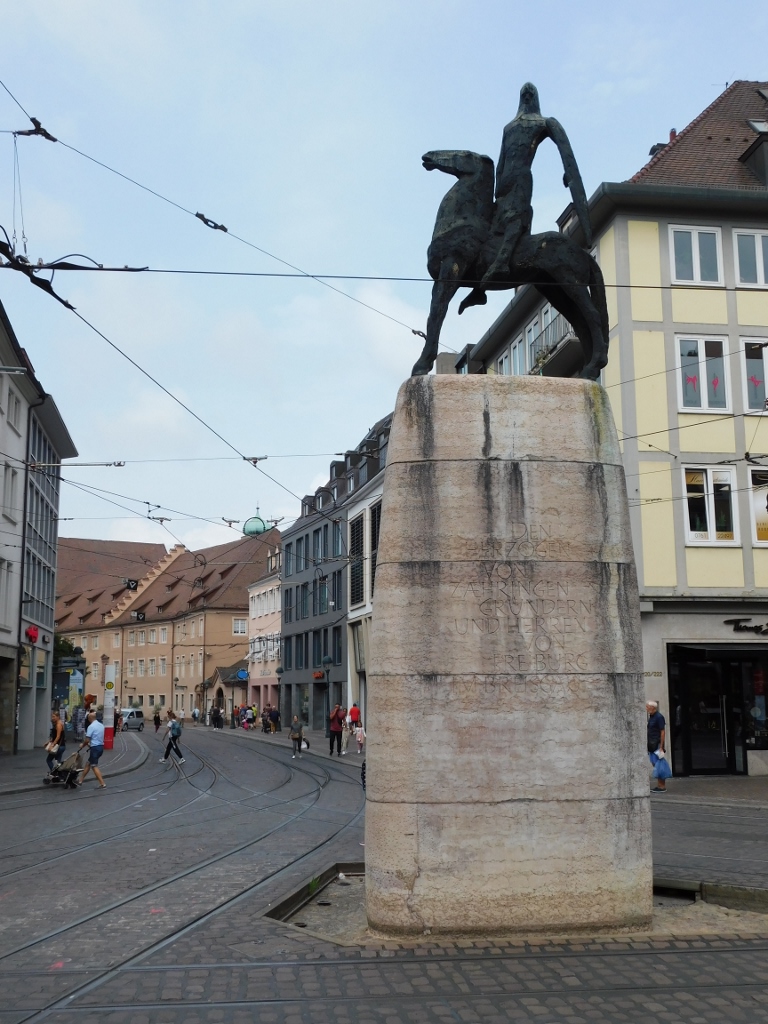 Bertholdsbrunnen
Bertholdsbrunnen
Namely, earlier in the past, there used to be a fountain in this part of the city that was later moved more to the north, while a new fountain, installed here in 1807, was dedicated to the founder of Freiburg. But, this fountain was also completely destroyed in the British bombing of the city in November 1944 and later a decision was taken that a comparatively abstract monument should be erected here. In other words, although the name suggests otherwise, this is not a fountain at all.
From here I could also have a nice view at Martinstor, a gate that is a part of the city ramparts from the 13th century, but I walked to it a little later.
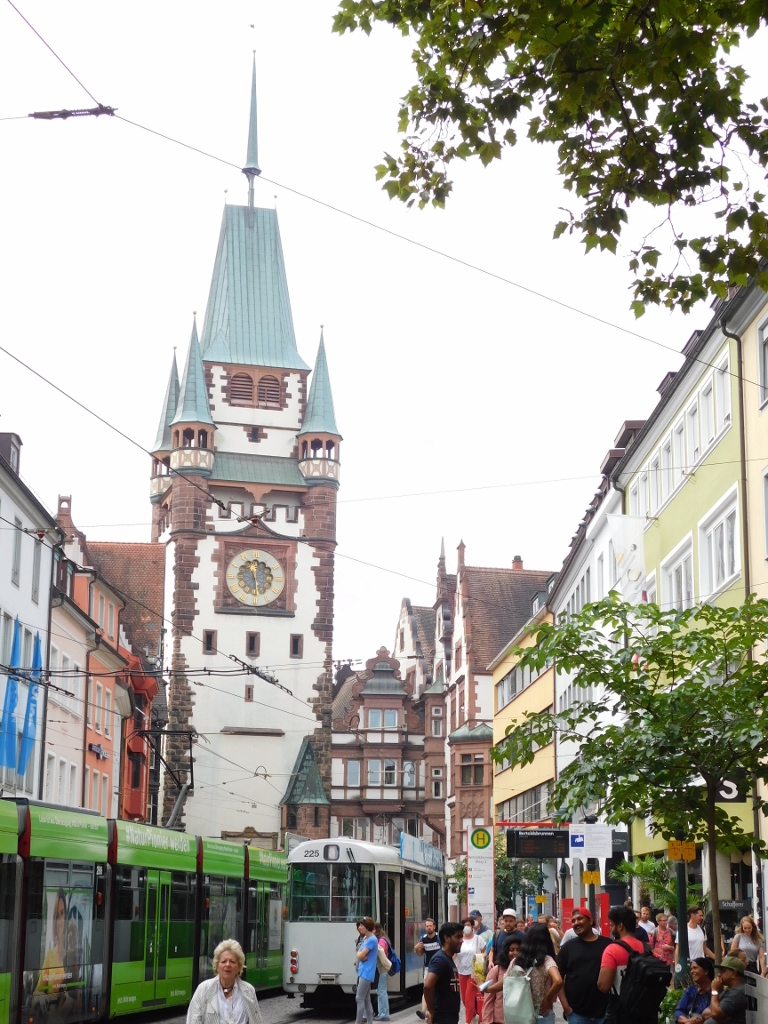 Martinstor seen from the direction of the city centre
Martinstor seen from the direction of the city centre
For now I headed towards a part of Freiburg University that was, as I’ve already mentioned, founded in 1457 which makes it the fifth oldest university in Germany. This is a large university that comprises 11 faculties and I certainly had no intention of visiting all of that, but rather I went only to the University Church, as this church is called nowadays, that is a part of the Old University (Alte Universität). The church was built in the second half of the 17th century by the Jesuits and for this reason it used to be called the Jesuit church.
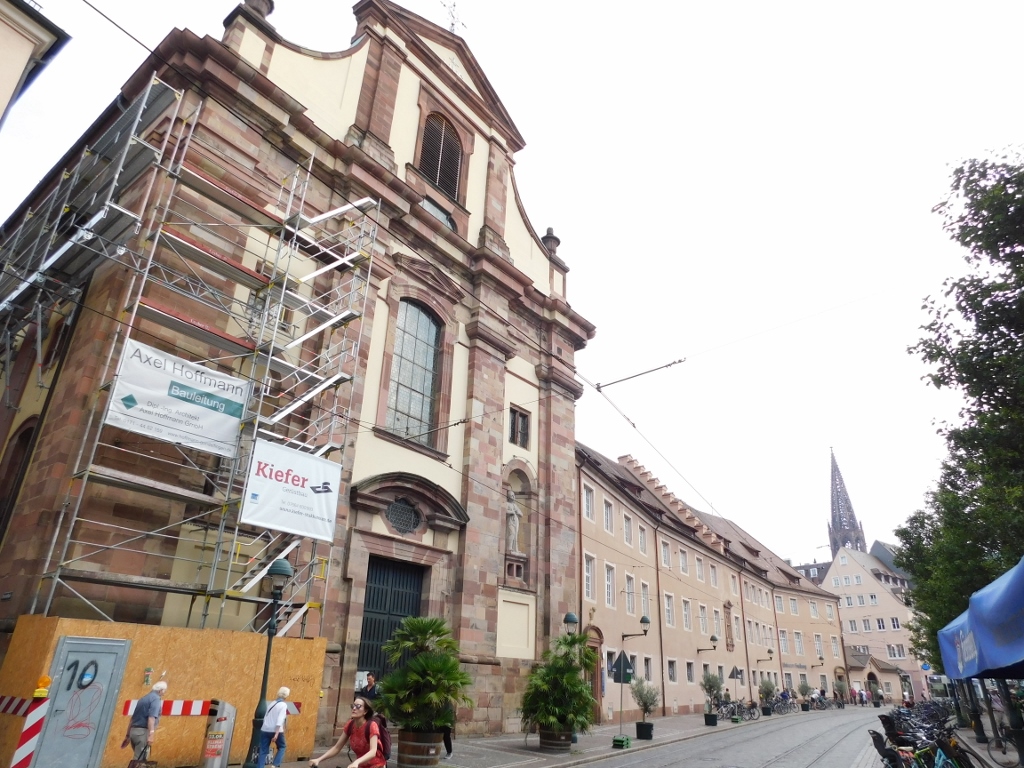 Front facade of the University Church and parts of the university
Front facade of the University Church and parts of the university
After a short stroll around the church and this part of the university, using some side streets with very picturesque buildings I continued towards the St Martin’s Gate, i.e., towards the Martinstor.
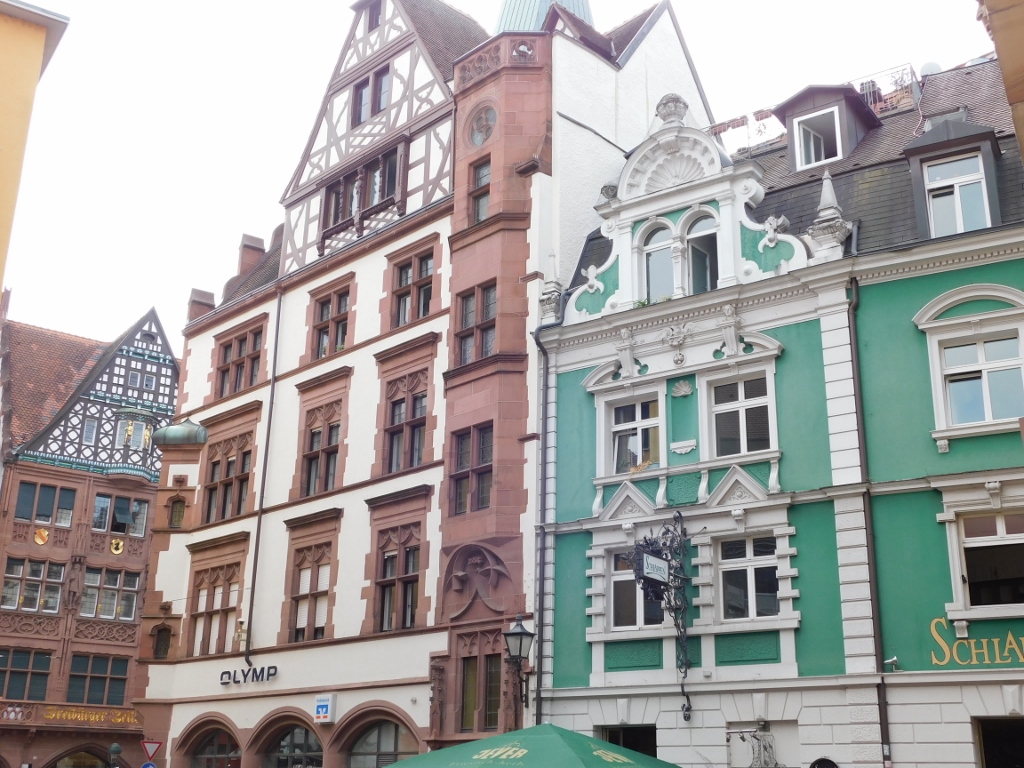 Picturesque part of Freiburg
Picturesque part of Freiburg
As for the Martinstor or St Martin’s Gate, this segment was built already at the beginning of the 13th century as a part of the city’s ramparts. Over time the gate was reconstructed several times, but mostly in 1901. Namely, in the meantime, the surrounding buildings became taller than the gate, while the technological development (trams) required a larger passage through the gate. There was a question whether to tear down the entire gate or not and in the end it was decided that the gate should be thoroughly modified. Its height was increased from 22 m to 60 m and a roof done in the 15th-century style was added as well. Also, another, lower gate was added, but with a larger passage.
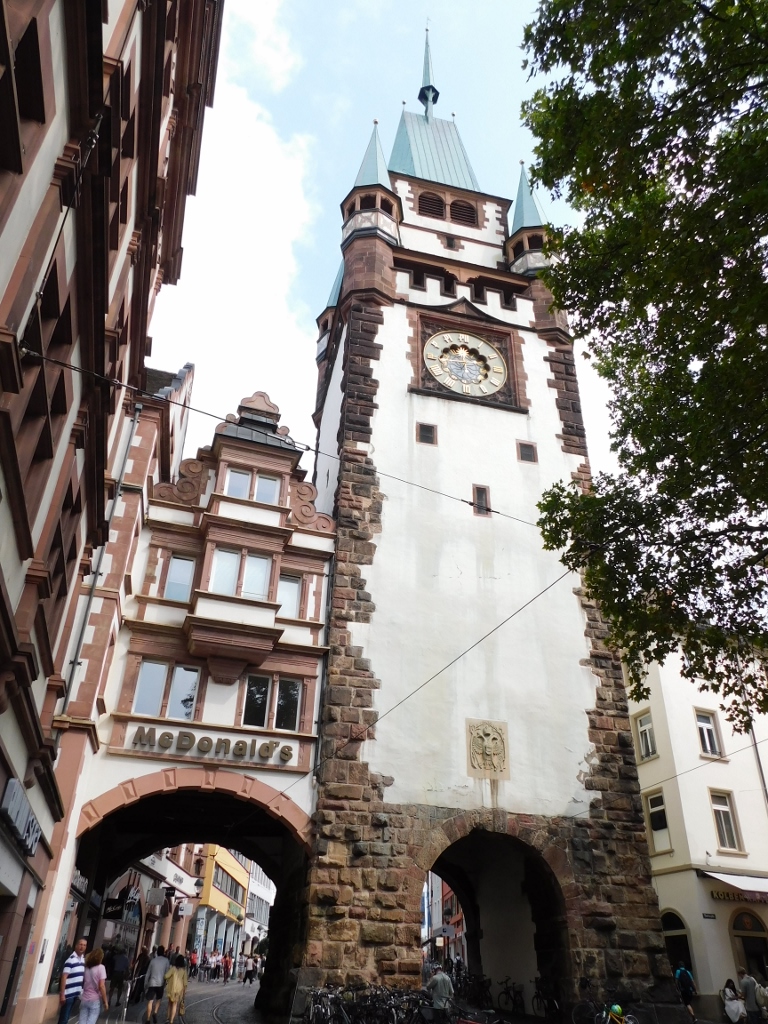 Martinstor seen from the “outside” in relation to the city centre
Martinstor seen from the “outside” in relation to the city centre
In the previous photo, the name of a well-known fast food chain may be seen at the lower gate. This restaurant was opened here and there was no way to prevent them from displaying their name, although the city did succeed in making them write the name in appropriate colours, rather than putting a bright red display. It is said that the residents are not happy about this at all (I was appalled), but this is a part of big business.
Here too, in the direct proximity of Martinstor, there is yet another drinking fountain. I have already mentioned that there are such fountains throughout Freiburg and it is interesting that the tourist maps that can be seen in several places also include these fountains and show which ones of them are safe for drinking water.
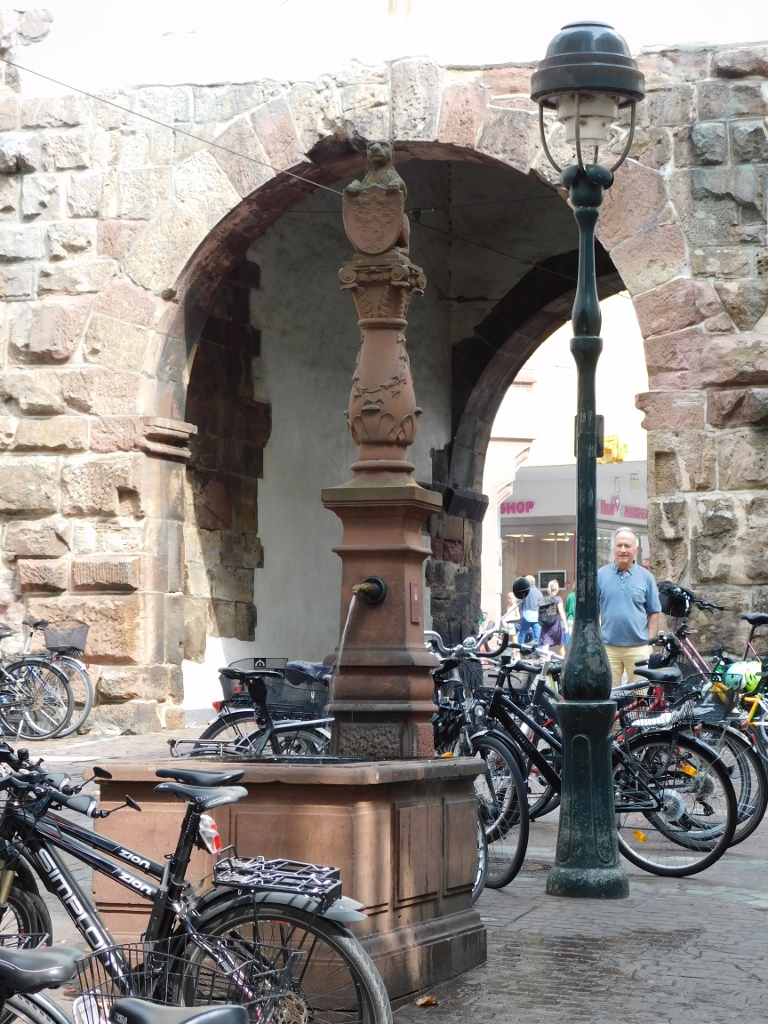 Fountain by Martinstor
Fountain by Martinstor
Right here from Martinstor also start two parallel streets that are exceptionally lovely and that should certainly be visited. One of them is Gerberau and the other one is Fischerau.
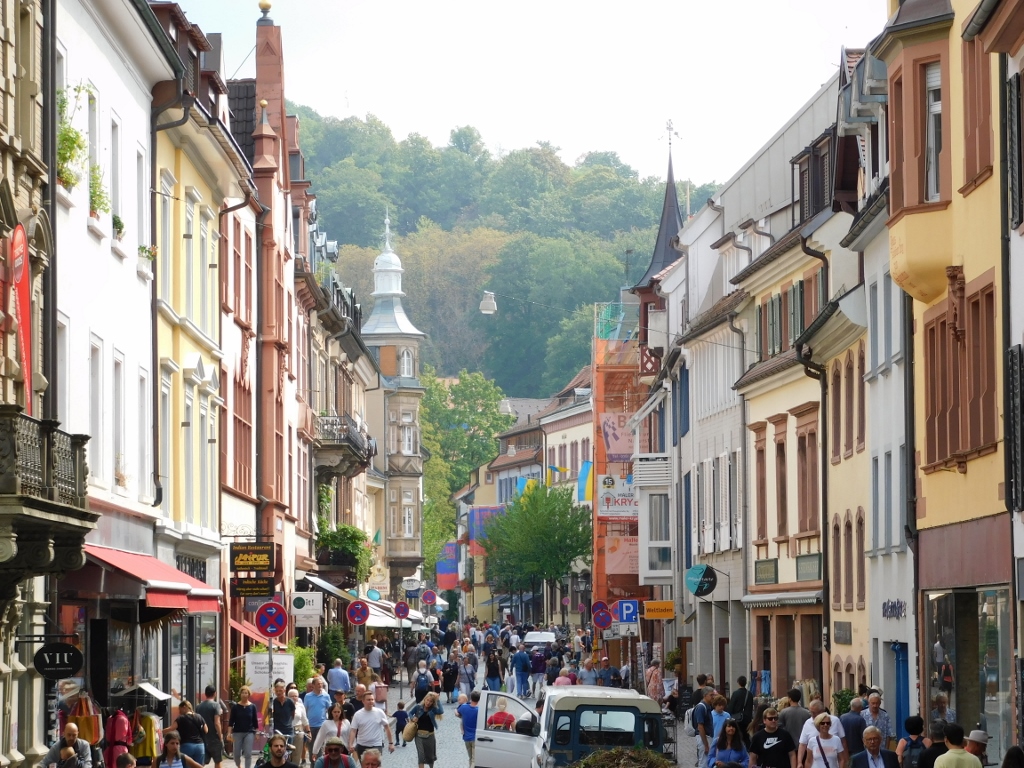 Gerberau street
Gerberau street
In the past, this was where tanners and fishermen used to work, which explains the names of the streets. Gerberau street is significantly more active and bigger, but I found Fischerau street visually much more interesting because of the Gewerbebach canal or Gewerbekanal. This canal is also a part of the Bächle system, i.e., of the “Streams,” the artificially made canals used for commercial purposes (for instance, here) or to provide water for extinguishing fires throughout the old town. The water was pulled from the small river Dreisam that runs not far from here.
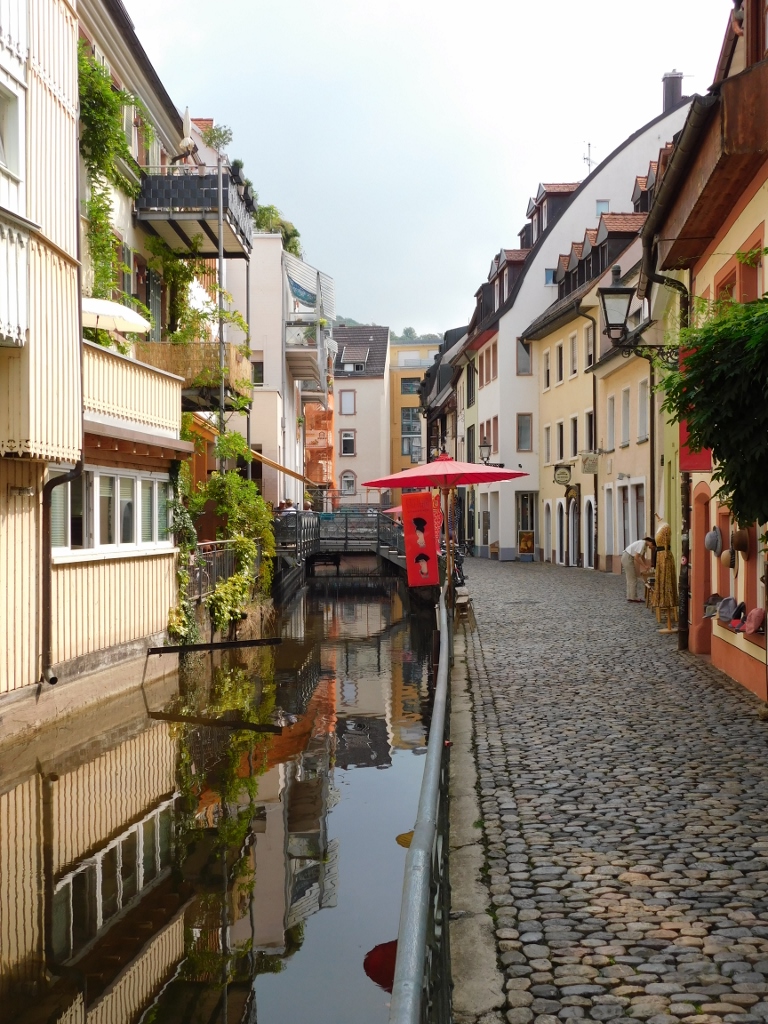 Fischerau street
Fischerau street
I also noticed a very pretty terrace here, so I wanted to have a coffee there. This was what I did do, but I had to enter the café from Gerberau street. Not a problem at all and the coffee was very good.
Following this fine break, I headed for yet another medieval gate and thus I first got to a small square with a 16th-century fountain, the Oberlinden Fountain (Oberlindenbrunnen).
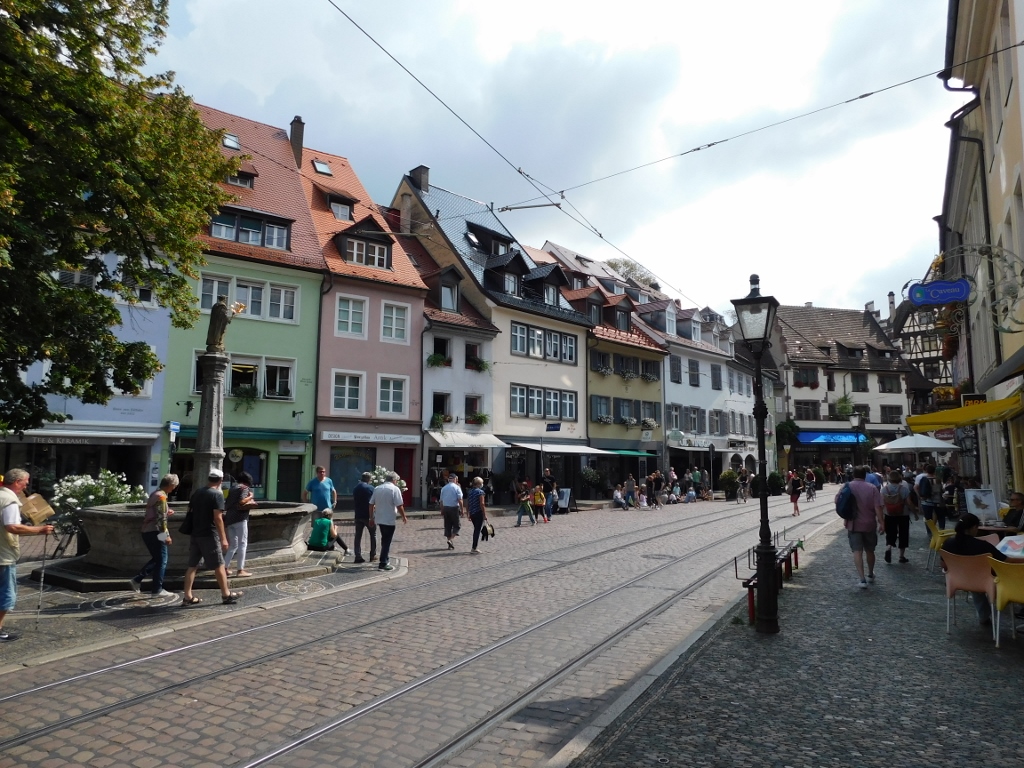 Oberlinden Fountain may be seen on the left-hand side of the photo
Oberlinden Fountain may be seen on the left-hand side of the photo
There is a linden tree by the fountain and this tree is documented to be around 300 years old (it was planted in 1729), while the oldest inn in Germany, from the 12th century, is also located in this square. I did not take a photo of it, since it was in the shade, i.e., not properly lit by the sun, but not to worry – it will certainly remain there and wait for some new visit to Freiburg.
Still, I did not go right away to this other gate I’m mentioning because I decided to have a stroll along a lovely street that some people claim is the most beautiful one in Freiburg. This is Konviktstrasse.
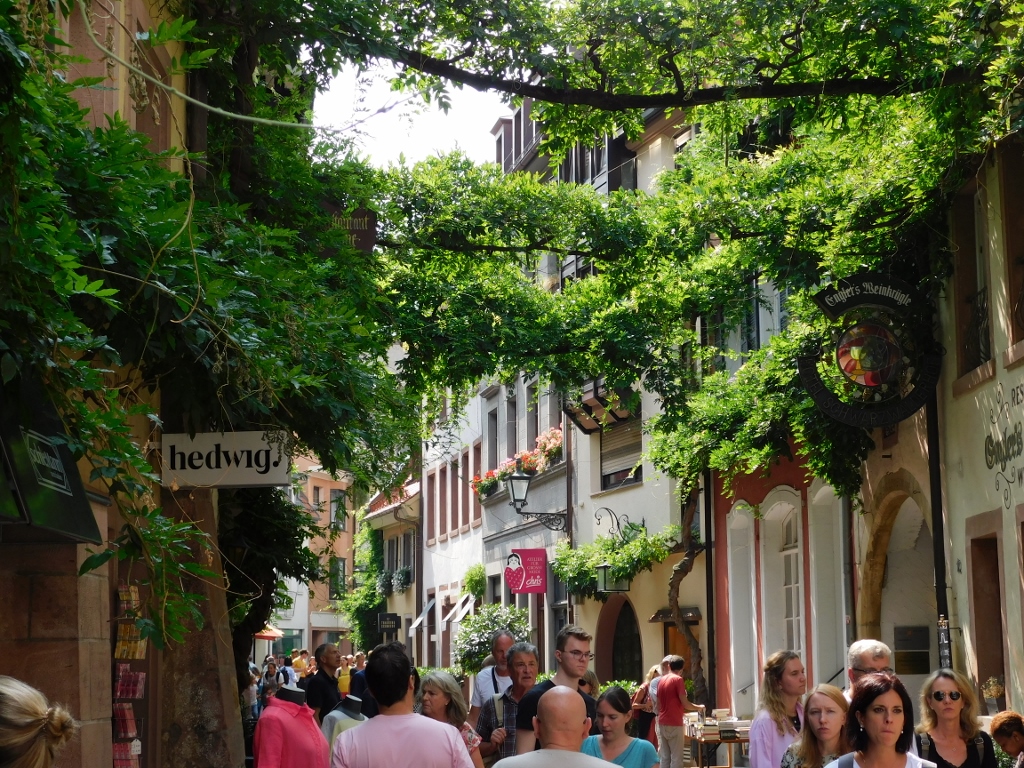 Konviktstrasse
Konviktstrasse
It was easy to remember the name of the street, since it sounds just like the English word convict! The other name used, Seminary Street, is much softer and it refers to the seminary located at the end of the street. In the direct proximity of it there is the seat of the Archdiocese of Freiburg.
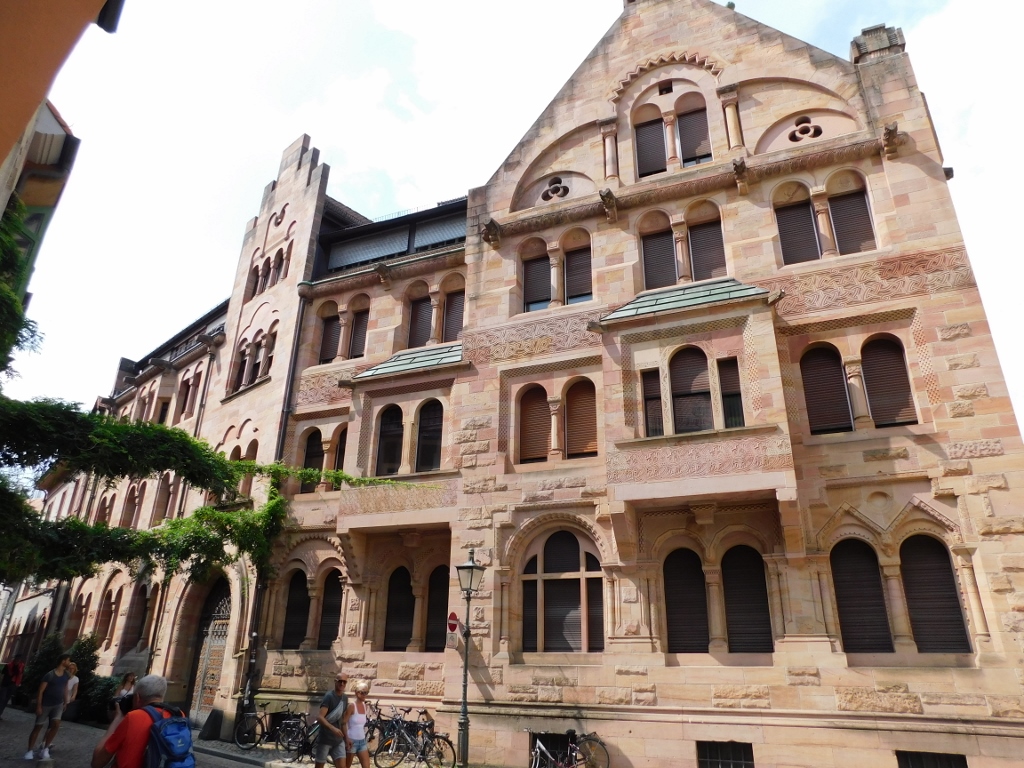 Administrative seat of the Archdiocese of Freiburg
Administrative seat of the Archdiocese of Freiburg
Then I returned to the main street walking back along this pedestrian street and approached the Schwabentor gate, but first I looked back and once again took a photo of Oberlinden street and the square.
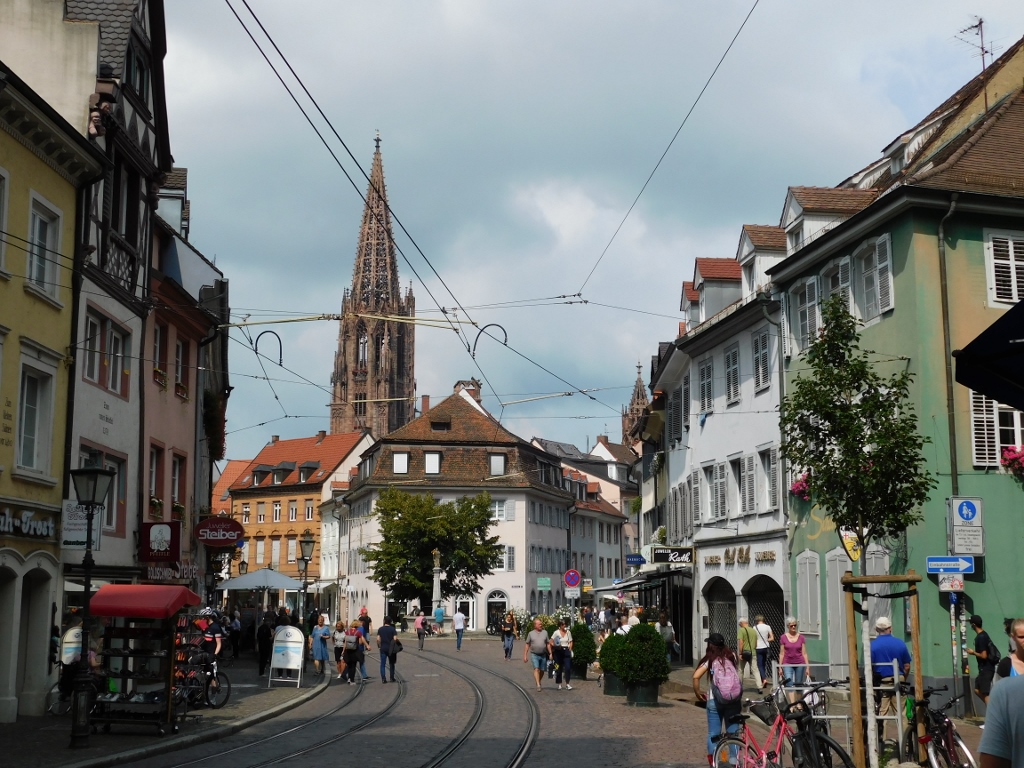 The west tower of Freiburg Cathedral may be seen in the background, while closer in the same direction are the old linden tree and the fountain; the beginning of Konviktstrasse may be seen to the right
The west tower of Freiburg Cathedral may be seen in the background, while closer in the same direction are the old linden tree and the fountain; the beginning of Konviktstrasse may be seen to the right
As for the Schwabentor, this is yet another medieval gate that used to be a part of the fortifications within which the city of Freiburg developed.
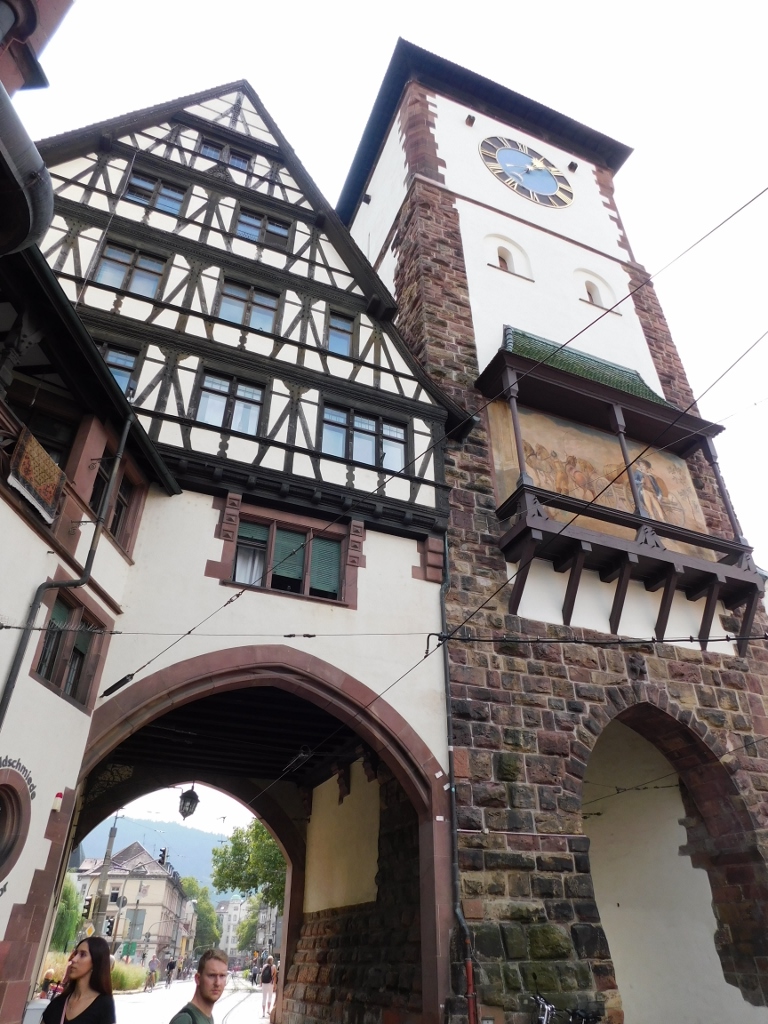 Schwabentor
Schwabentor
The name of this gate means “Swabian Gate” and relates to the region of Swabia in the southwest of Germany. The gate and the tower were built in 1250. Like in the case of Martinstor, the main modification to the gate took place at the beginning of the 20th century when its height was almost doubled, but in 1954 the roof of the tower was reduced and simplified.
On its outer side I saw yet another fountain and I also had enough space here to move backwards a little and take another photo of the gate, now lit by the sun.
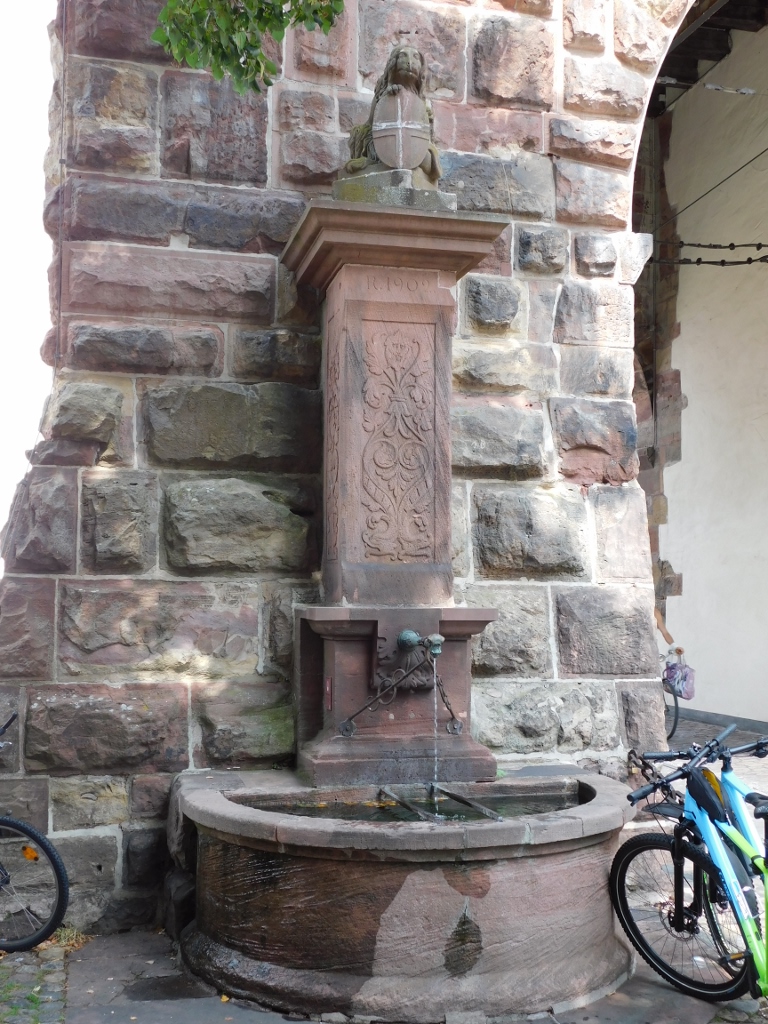 Fountain on the exterior side of Schwabentor
Fountain on the exterior side of Schwabentor
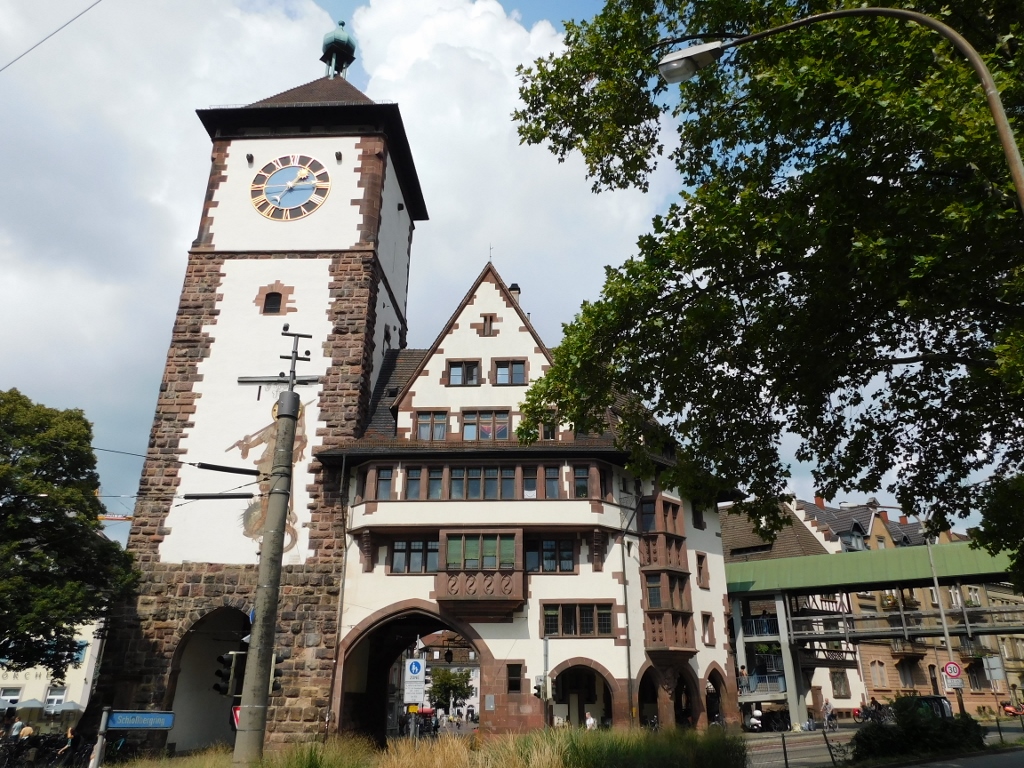 Schwabentor
Schwabentor
Now I began to climb a hill called Schlossberg that starts right by Schwabentor. Its name means “castle hill” and I saw in my materials that there was a tower on top, so without getting into the details, I thought this was a medieval tower and thus I pressed on.
It is a fact that along the way there are several spots from which there is a lovely view at Freiburg, but... While climbing the steep Schlossberg hill in extremely high air humidity, which only tired me additionally, I wondered why I was doing this at all.
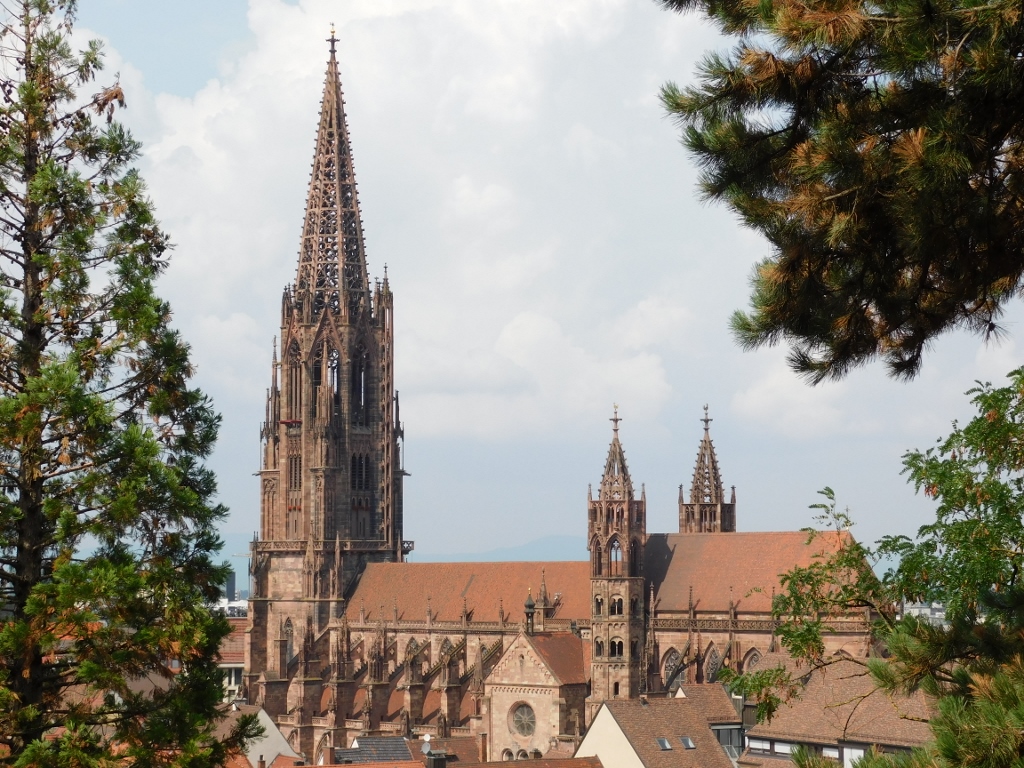 Fine view at Freiburg cathedral
Fine view at Freiburg cathedral
The only good thing was that I came across four young Indians who were all ICT specialists working in Germany and who came here for a trip. We chatted nicely and this made all the exhausting climbing slightly bearable.
And then I got to the top and the tower.
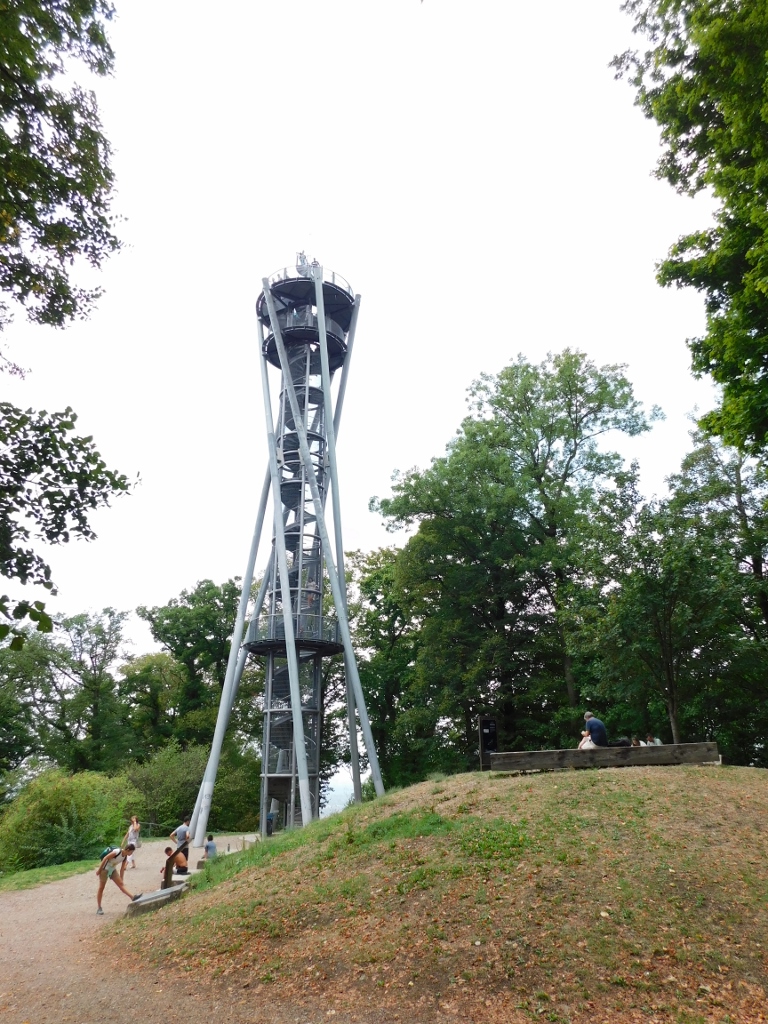 Tower on the top of Schlossberg
Tower on the top of Schlossberg
Needless to say, I had no idea whatsoever to climb here as well, but rather I only strolled a little around the top of the hill. The fact is that various remains of fortifications built since the 11th century can be seen here, but I was no longer interested in this subject.
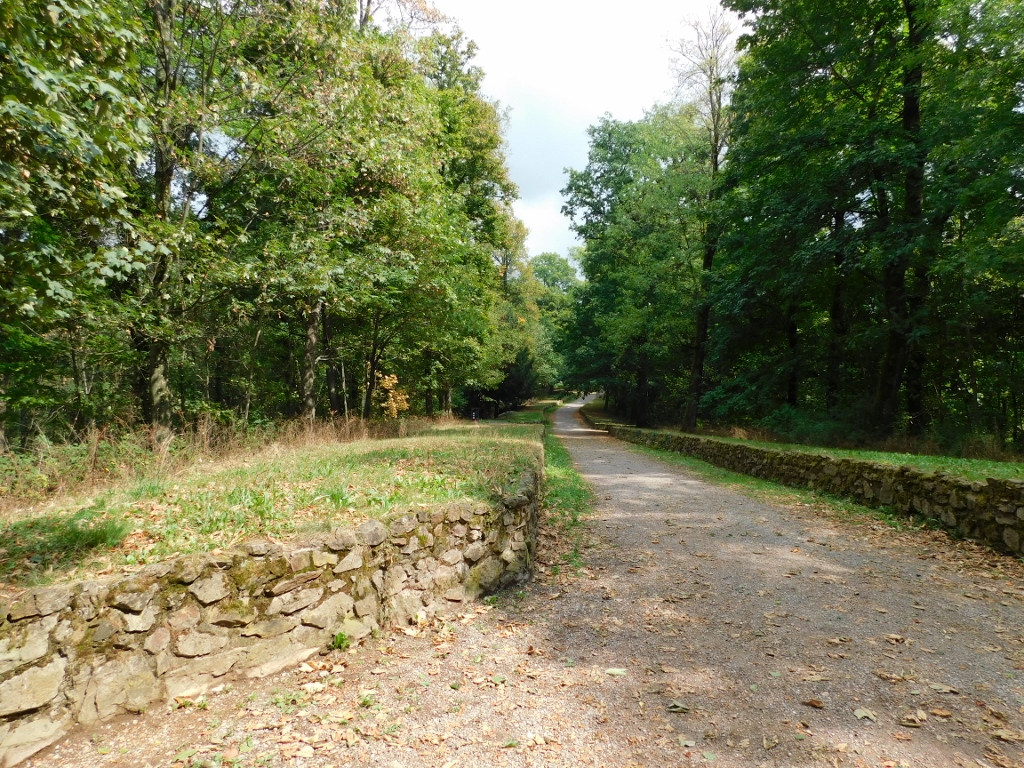 Remains of the former fortifications on Schlossberg
Remains of the former fortifications on Schlossberg
Instead I headed back towards the foot of the hill, but now it was easier for me to walk and breathe, so I was ready to take photos more often. The forest here is actually really beautiful and there are numerous wider and narrower trails that can be followed.
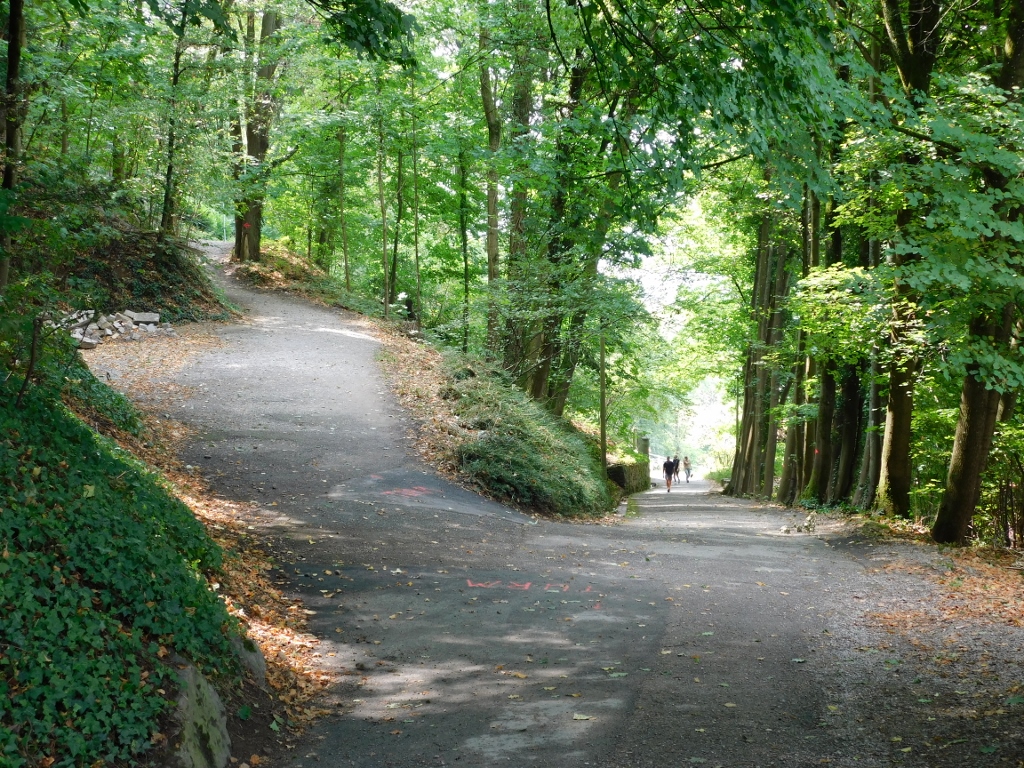 Schlossberg hill, a detail
Schlossberg hill, a detail
The hill can also be climbed, and certainly descended from, by a cable car that starts from the City Park (Stadtgarten), but one needs to bear in mind that the cable car does not go all the way to the top and so from the upper station one still needs to climb some more.
Now, I only went down to the City Park and from there I headed back in the general direction of the Cathedral or Minster Square.
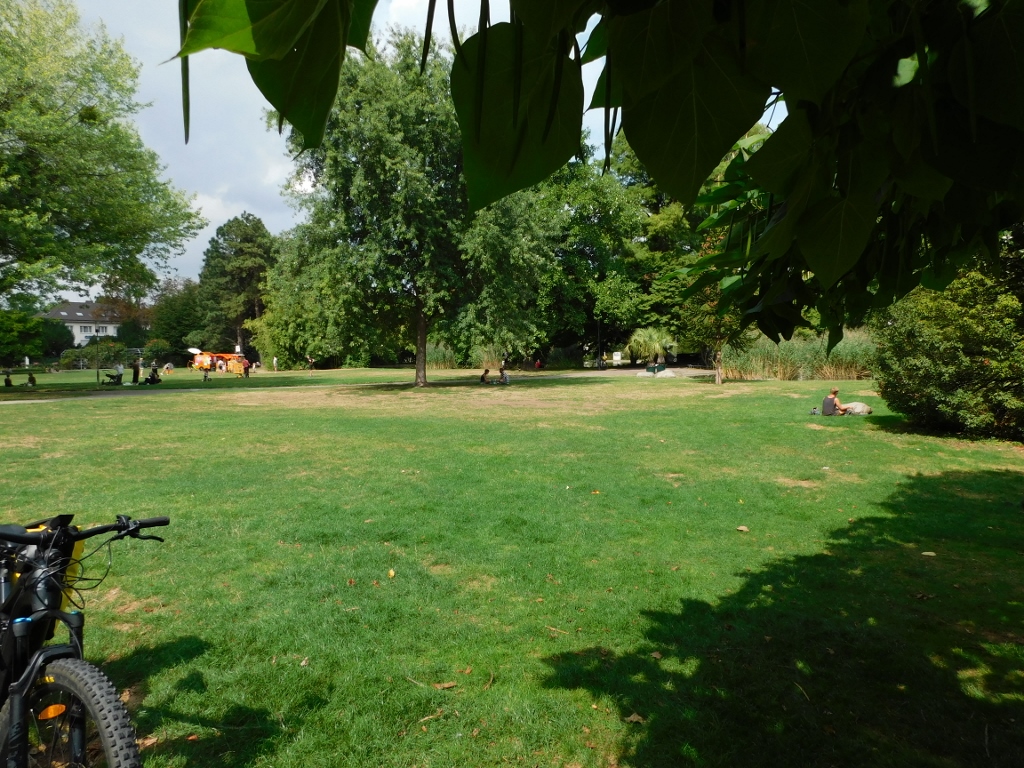 City Park, a detail
City Park, a detail
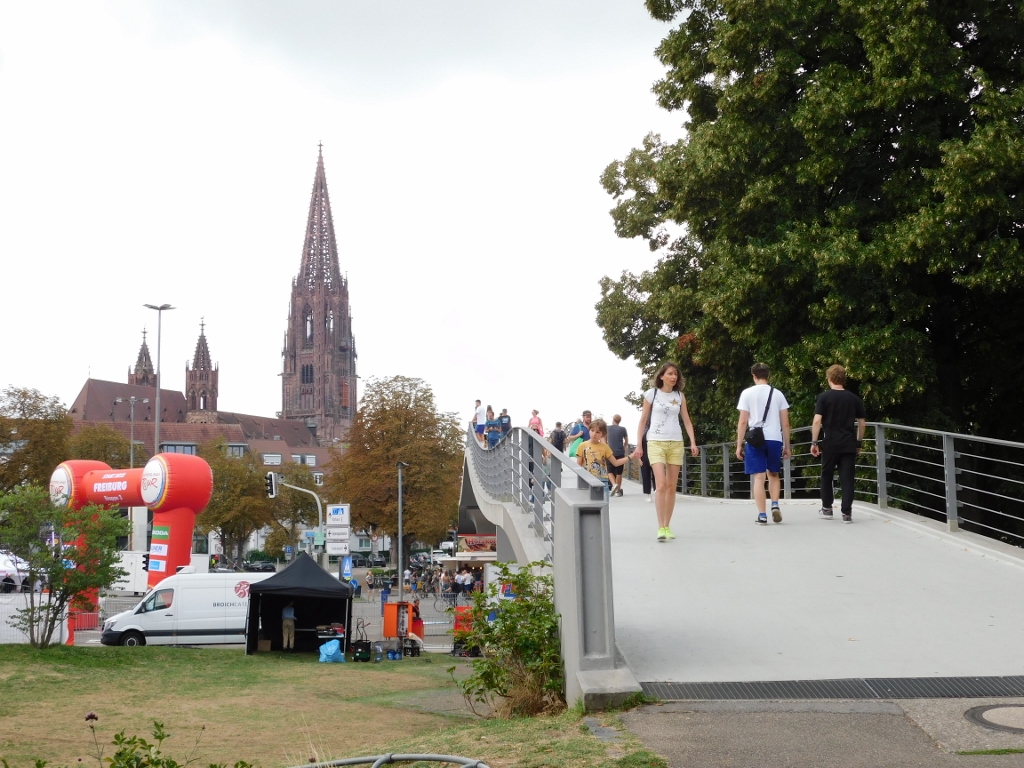 Walk from the City Park towards the Minster Square
Walk from the City Park towards the Minster Square
On my way I often walked along the streets in which it was possible to see the Streams or the Bächle.
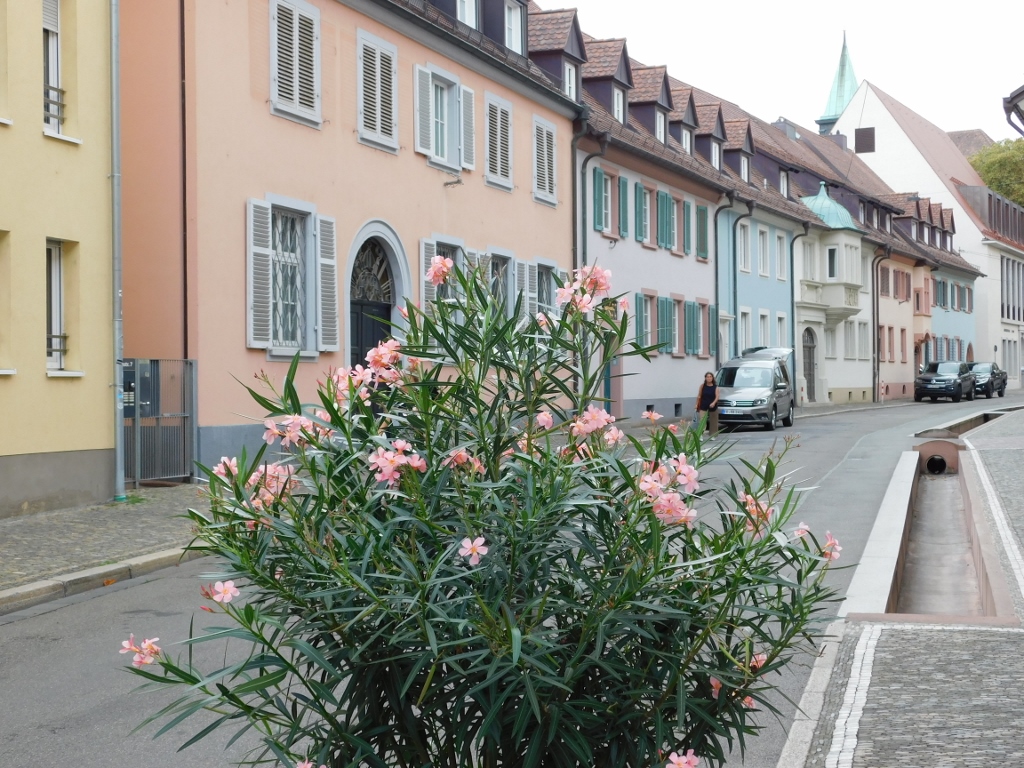 Freiburg, a detail
Freiburg, a detail
Just as I approached the Minster Square, I realised I had not eaten anything during the day. My plan was to go for dinner at the same restaurant where I had been the night before, but I was still supposed to eat something beforehand. And, as I was pondering about all of this, I reached the square and then I suddenly realised there were food stalls there. And what food that was! Various German sausages which I love. I did not hesitate for a second and got in the line right away, since it was quite crowded in front of the sausage stall.
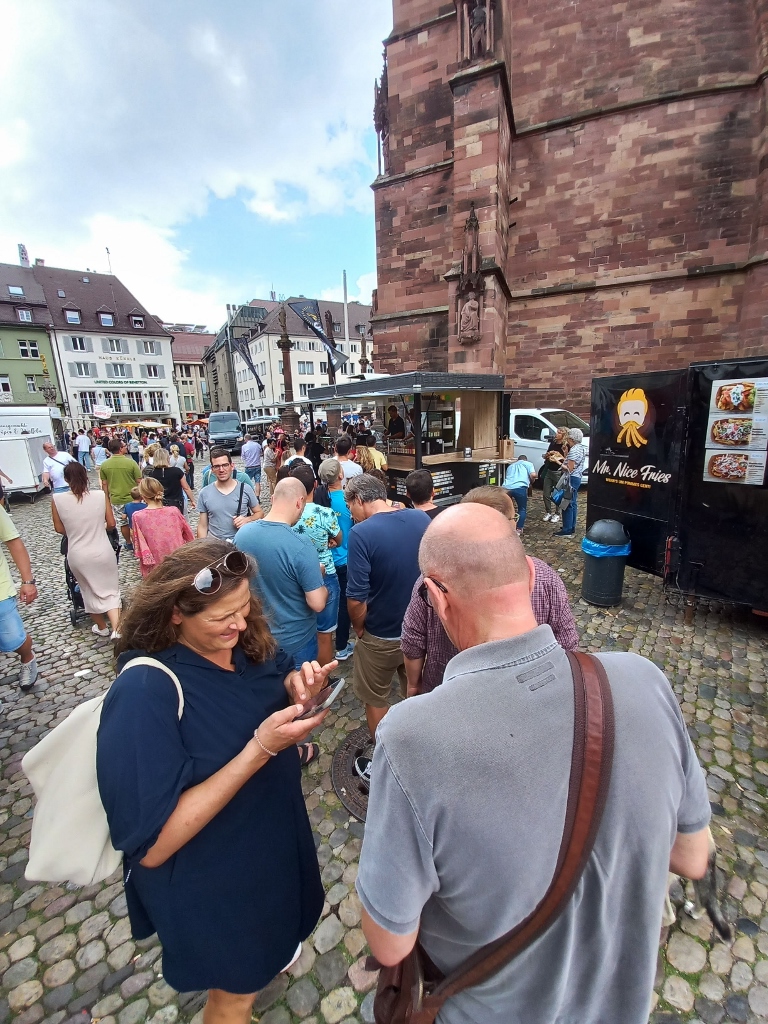 Waiting line for sausages
Waiting line for sausages
I could not help but notice one of the neighbouring stalls that offered vegan food. It may be healthy, but it was certainly not very popular.
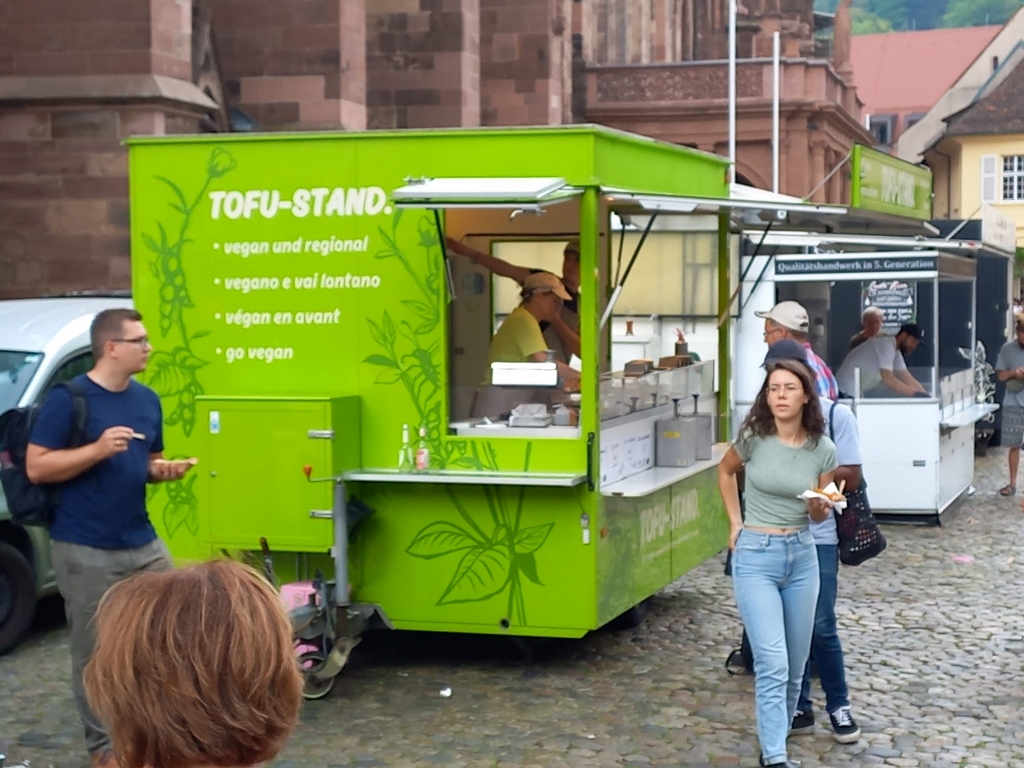 Vegan food stand
Vegan food stand
When my turn came up, I had a serious problem to make up my mind – like a child in a candy shop.
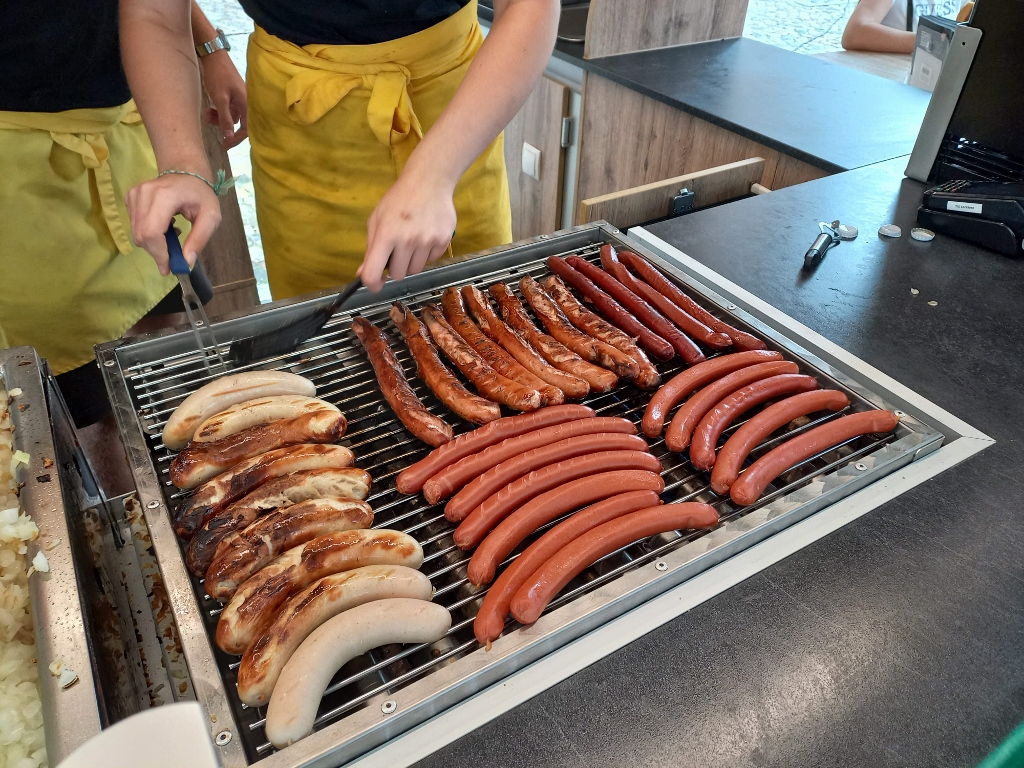 Sausages offer
Sausages offer
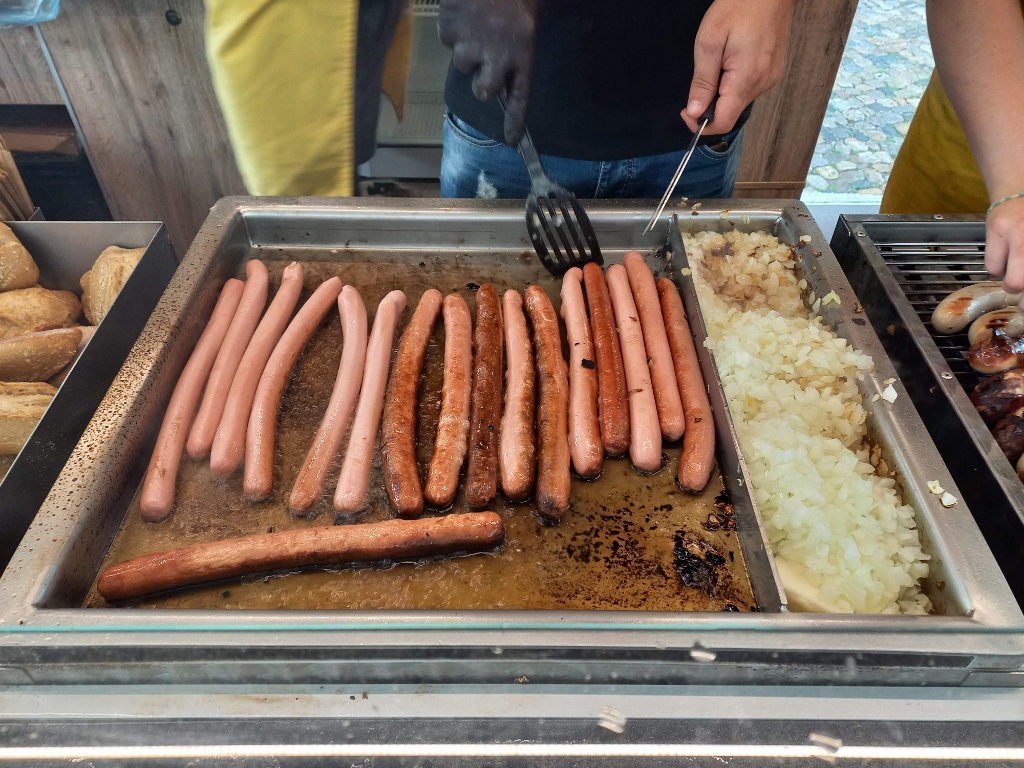 Sausages offer
Sausages offer
While I hesitated which sausage to take, the girl I was paying to suggested the “traditional” one. I accepted and here is the result:
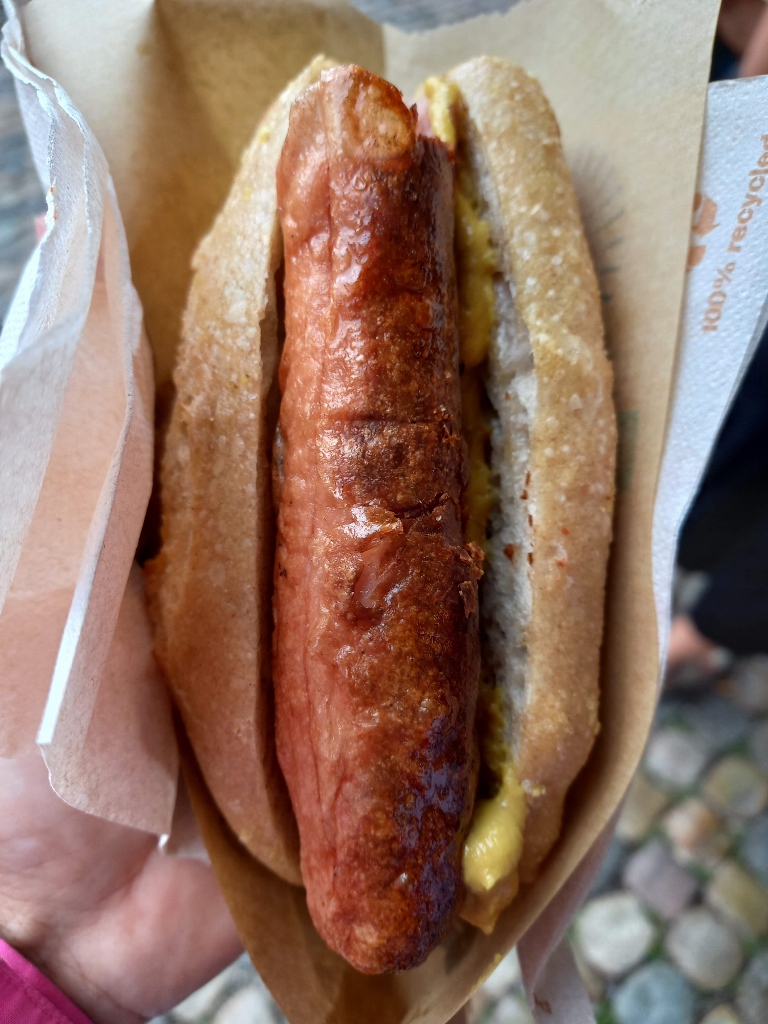 Fantastic German snack
Fantastic German snack
Although I got back to my hotel early enough, soon a heavy thunderstorm began and I really enjoyed having the rest in my room. On the other hand, since I also had a beer in the meantime, I was still full in the evening, so the dinner was out of question. But, this was nonetheless a very tasty and satisfactory end of my brief stay in Germany.
The next morning I was going back to France.